Boat Navigation Lights Rules: Illustrated Beginners Guide
When navigating at night, the lights on other boats are your first clue about the moving dangers around you. And your navigation lights are your first line of safety in avoiding collisions in the dark, and they tell others vessels what you are and what you are doing. The rules sound complex, but with a little understanding you can get the basics for any situation.
So what are the basic navigation light rules? For most small vessels, motoring requires red and green (port and starboard) lights, and a white light visible in all directions around the boat. This is almost always a stern light and a masthead light on sailboats. Boats under sail require port and starboard lights, and a white stern light. Sailboats below sixty-five feet may show a tricolor light at the masthead instead of side and stern lights when sailing.
That's it, in a nutshell. There's a little more to it, as the rules change with different sizes and there are some specifics about angles of display for the colors. Identifying other ships at sea requires more study, but the basics are the same. And it's not much trouble to make sure you've always got the proper lights on your vessel.
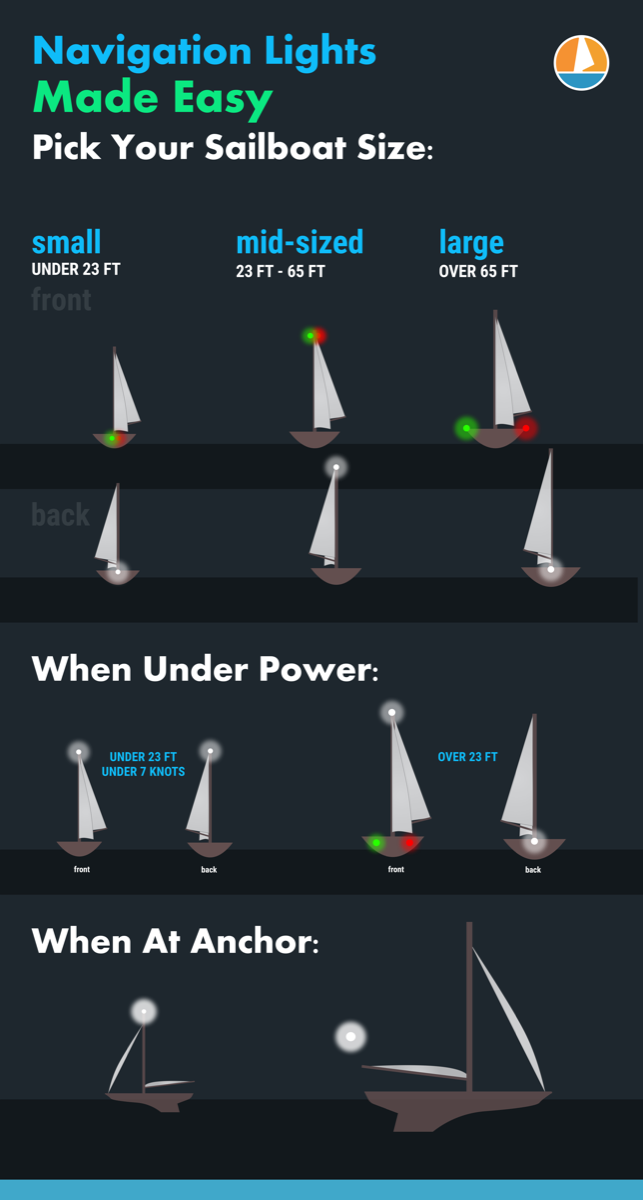

On this page:
What are the official colregs rules for your sailboat, what about the uscg (united states coast guard) rules, lighting at anchor, identifying the boats around you.
The International Regulations for the Prevention of Collision at Sea , abbreviated "COLREGS" is very specific about the lights required, their shapes and sizes, and the distance they must be visible. For the smaller boat, the following definitions apply.
- Masthead Light - a white light placed centerline on the boat showing an arc of 225 degrees with 112.5 degrees either side of the front of the vessel.
- Sidelights - A red light on the port side and a green light on the starboard. They must show an arc of 112.5 degrees from centerline of the bow.
- Stern light - A white light on the stern of the boat showing an unbroken arc of 135 degrees from centerline of the vessel.
- All-round light - A light showing in an unbroken arc of 360 degrees.
The good news is you need not measure these angles. Any properly installed USCG or COLREGS approved light which will cover the correct arcs. If you have to replace the original light from your boat, make sure it's with an approved replacement.
Lights When Sailing
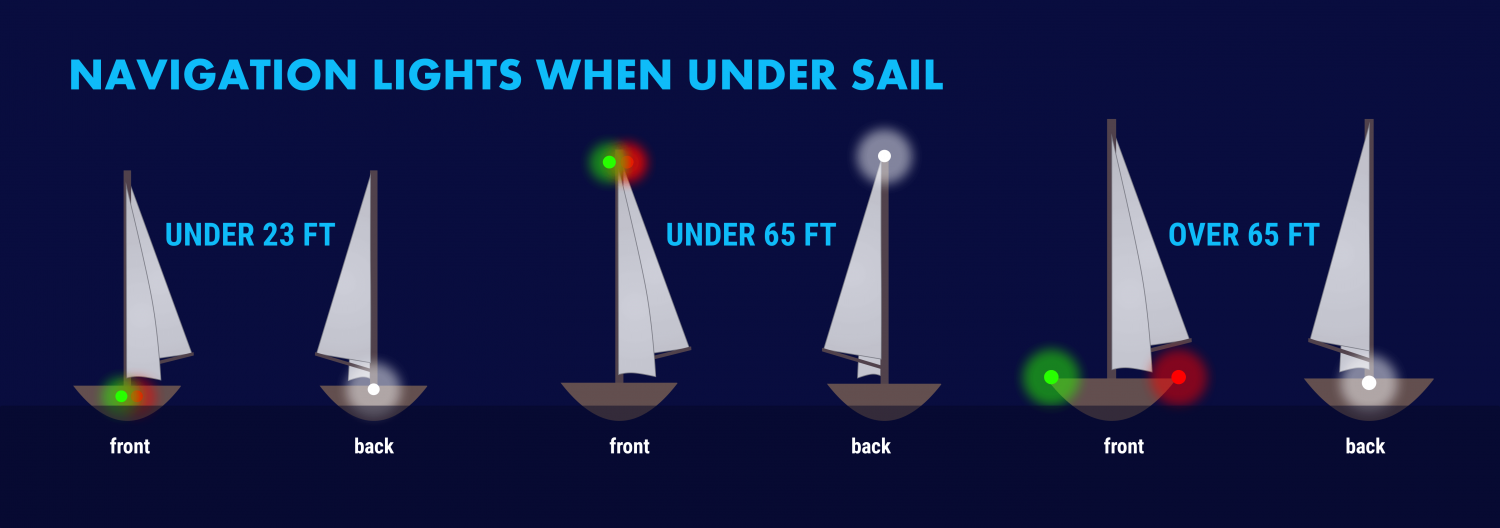
The specific rules for a sailboat under sail are in COLREGS Rule 25 and vary slightly with the size of the boat. A sailboat powering is considered a power boat and falls under in Rule 23.
- Under 23 feet (7 meters) - side lights and a stern light, possible. If these lights can not be displayed a light must be kept at hand to help avoid a collision. This can be a bright flashlight.
- Over 23 feet - Side lights visible to one nautical mile and stern light visible for two.
- Vessels under 65 feet may combine both sidelights into a single lantern on the bow.
- May show a tricolor light on the masthead instead of sidelights and a stern light. It's one or the other though, do not show these lights at the same time .
- Masthead light must be visible for three nautical miles, all other lights must have a two nautical mile visibility.
- Side lights must be separated.
- May not show a masthead tricolor light.
- Masthead light must have five nautical mile visibility, all other lights must be visible for two nautical miles.
- Optional masthead lights - any vessel under sail may display a red light over a green light at the masthead with sidelights and stern light. The red over green may NOT be displayed with a masthead tricolor light. It's one set or the other.
Lights When Motoring
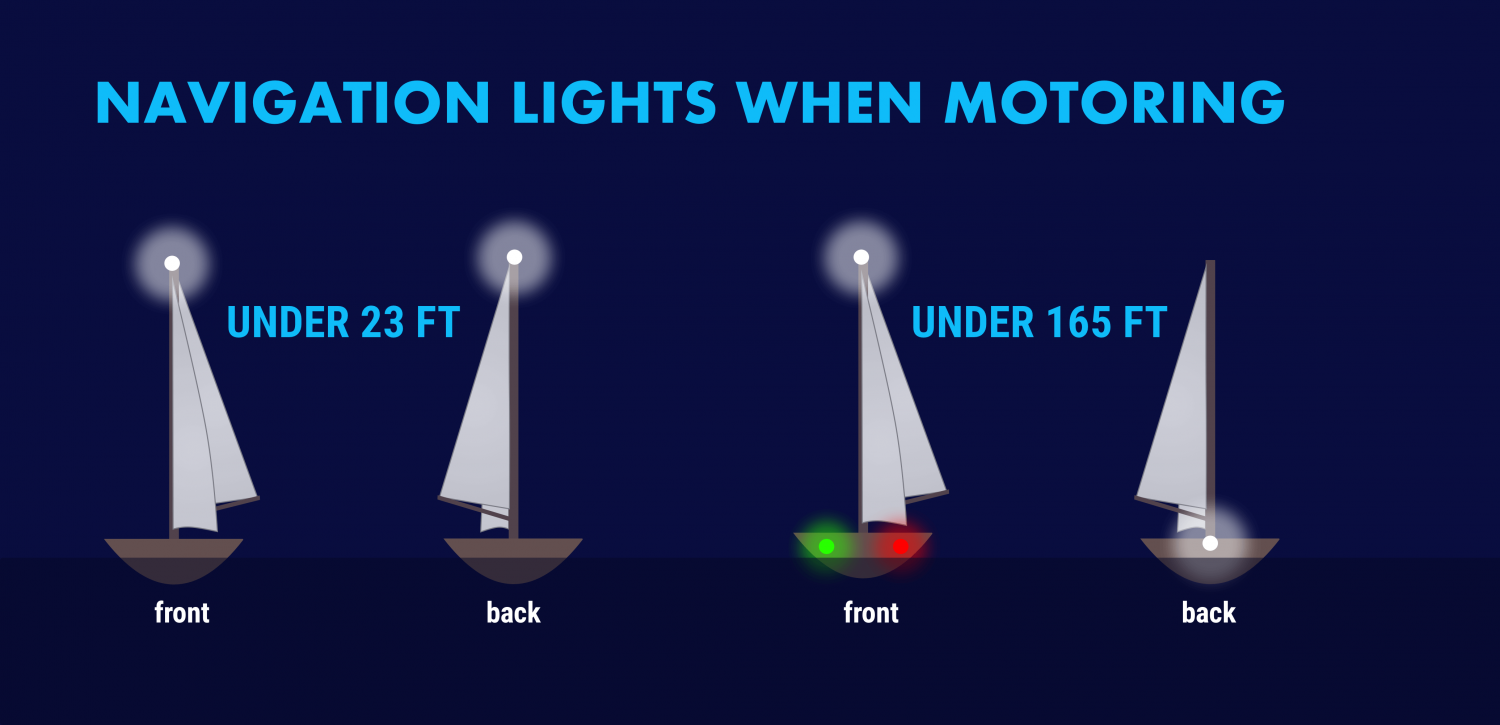
For all navigational purposes a sailboat under power is considered a power boat. This includes motor sailing - if the engine is on and providing propulsion you are on a power boat, even if the sails are up . This applies to navigation lighting, sound signals in fog and limited visibility, and rights of way.
Sailboats under 50 meters under power need to show:
- A masthead light
- Stern light
A power-driven vessel under 23 feet (7 meters) that does not exceed seven knots of speed may display an all around white light, though sidelights should be used if available.

The USCG has published its own "Rules of the Road" that are based on the COLREGS. In addition, it has rules for the "Inland Waterways" for rivers, inland lakes and the Great Lakes.
The good news is this has no impact on what you have to do with your own boat.
They mostly relate to lighting changes on towed vessels like barges and tugs. For example, a vessel towing or pushing another vessel in the ocean under COLREGS shows two masthead lights, sidelights and a stern light, whereas in Inland Waterways the towing or pushing vessel displays two yellow towing lights instead of a white stern light.
If you sail on lakes, rivers or the Great Lakes where towed commercial traffic is common you should learn the inland lights, but coastal or ocean sailors will never see these.
When you anchor outside a designated mooring field, you should display an all around white light at the masthead or as high in the boat as practical.
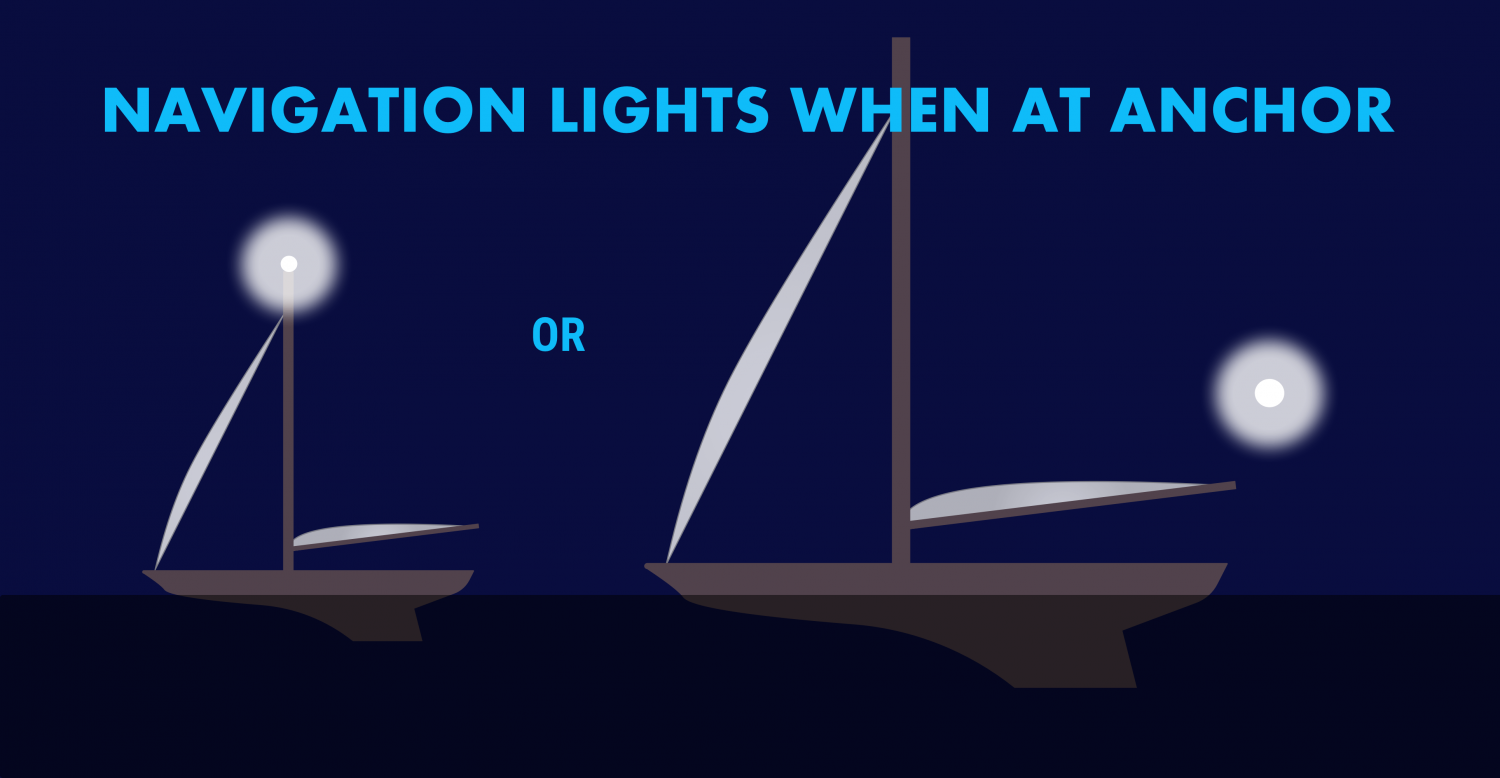
If your boat is large and has a very tall mast, you may wish to display another light closer to the waterline. Boats approaching in the dark may not see a light on a mast sixty or seventy feet in the air when they are close to your boat.
We use a simple garden path light on our stern when we anchor, left in a rod holder or flag socket. It comes on automatically at dusk and is a cheap and easy way to be more visible. There is no specific rule stating you can not display more lights than required, or the nature of any lights beyond the required all around light.
The COLREGS also specify that a round black "daymark" should be displayed in the rigging of any vessel at anchor. Very few small vessels observe this, however it is the correct display for a vessel in an anchorage.
If you tie to a mooring in a marked mooring area you are not required to display anchor lights, but there is no harm in doing so.
The other important reason to know your lights is to figure out what's going on around you at night. The water may be ablaze with white, red, green and other lights at night and they are your first key to avoiding collisions and problems.
All combinations of lights for fishing boats, commercial vessels, and so on are outside this post‘s scope. The odds are small you will encounter a submarine, seaplane or hovercraft at night, but there are regulations regarding specific lighting for each of those vessels!
There are a few fundamentals to help you figure out what that is you see on the horizon, which way it is going, and whether it is a danger to you.
Port Wine is Red
The fundamental rule is that red sidelights will ALWAYS be on the port side of a vessel, and green lights will always be on starboard. However, some vessels can use all around red and green lights for other purposes, though those will be higher than sidelights.

The light‘s on a ship is not important, some large tankers and freighters will have their sidelights far aft and put them on the superstructure for better visibility. It is not safe to assume that sidelights you can see are on the bow of large vessels .
When you can see the color, you know which way the bow is pointing. If it's red, it's pointing more or less to the left and will travel in that direction. A green light shows it is heading more or less to your right.
If you can see the red and green lights at the same time, you are looking directly at the bow of the vessel. When you are far away, this isn‘t as alarming as if you are close crossing. Seeing red and green lights together on a vessel is something you never want to see for long.
Be aware of red and green lights used in combination with other red, green and white lights. These may not be running lights and could have other significance.
Tankers, Freighters and Large Ships
Tankers, freighters and large ships will have side lights, a stern light and a masthead light. In addition, on vessels over 50 meters there will be a second masthead light further aft and higher than the forward light. The masthead light positions are a better tipoff to the bow direction and how far from the bow the sidelights might be. Remember - on a large vessel the sidelights may not be at the bow or even close to it.
USCG Inland Rules allow for a second all-around white light on large vessels on the Great Lakes instead of a second masthead light.
Fishing Boats
Fishing boats engaged in fishing will have more complex light displays. When they aren't fishing, they will show lights like any power vessel, but Rule 26 spells out light combinations that vary by the fishing activity being done. In general:
- Boats which are Trawling but not making headway will display a green all-around light over a white all-around light , and a masthead light aft of these lights. Boats making headway while trawling will show these lights, plus sidelights and a stern light.
- A vessel fishing other than trawling will show a red all-around light over a white all-around light . When making way they will also show sidelights and a stern light.
- If a vessel has gear more than 150 meters away from the boat, it will show a second all around light in the direction of the gear. The best rule is to give fishing boats as wide a berth as you can at night. They're easy to pick out if you check the top light configurations but their course may be difficult to predict.
Towing and Pushing
Towed vessels can be the most dangerous to cross, but they have the most lights to tell you what is happening. Refer to COLREGS or the USCG Rules of the Road Rule 24 for all combinations You can pick a tow/push vessel out with the following lights:
- Two or three masthead lights in a vertical line. Three masthead lights shows a tow over 200 meters. Additional masthead lights may show for larger tow vessels.
- A towing light (yellow light with the same characteristics as a stern light) directly above the stern light.
- The will also have side lights and a stern light.
- The towed vessel will show sidelights and a stern light. Lighting may vary under USCG inland rules, where towing lights may replace stern lights. Learn these differences if this is your regular cruising ground. If you think there is a tow ahead of you, always go well behind the aft most set of lights. Never go between a tow and avoid crossing ahead if possible as it may restrict their maneuverability.
Special Situations
There are several rare situations you may encounter. As a general rule, if there are a lot of lights and you don't understand them look for the sidelights on a moving vessel. If you can find them and figure out the direction it is moving, it makes the vessel easier to avoid. Stay well clear of lights you do not understand if you can avoid them without risk.
Most of these signals are used by larger, commercial vessels and you will not need them.
They use these light combinations with other light combinations. For example a towing vessel may also be restricted in maneuverability, and a vessel constrained by draft will show running lights if moving.
- Not Under Command - two all around red lights in a single line
- Restricted in Ability to Maneuver - red, white then red in a single line
- Constrained by draft - three all around red lights
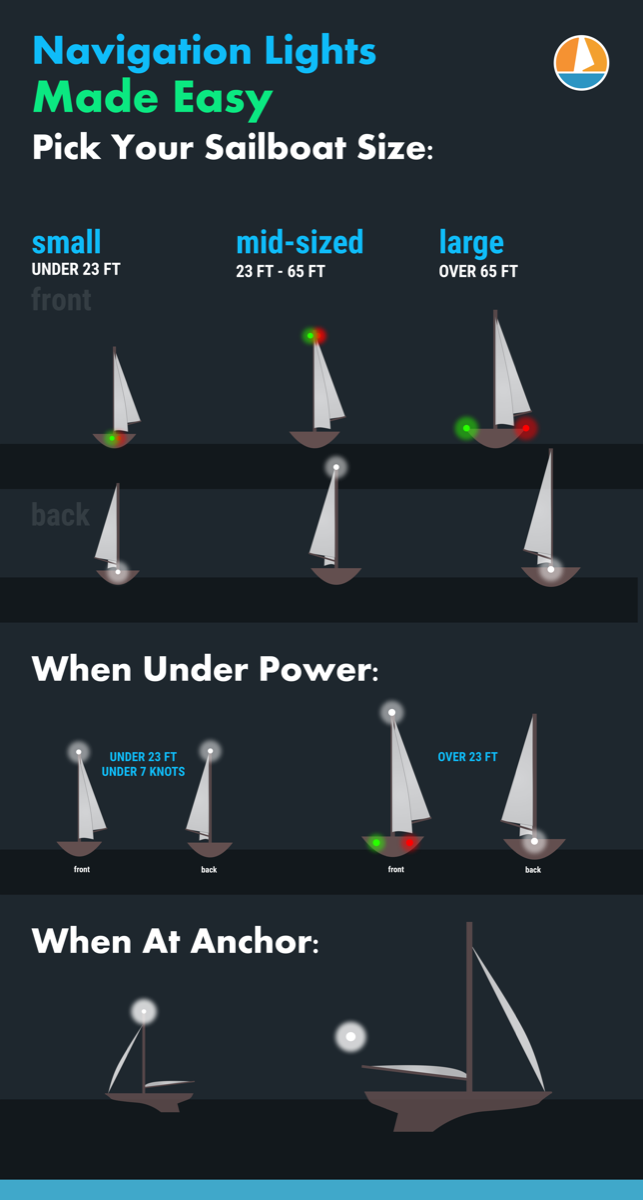
Leave a comment
You may also like, 17 sailboat types explained: how to recognize them.
Ever wondered what type of sailboat you're looking at? Identifying sailboats isn't hard, you just have to know what to look for. In this article, I'll help you.

The Ultimate Guide to Sail Types and Rigs (with Pictures)
Own your first boat within a year on any budget.
A sailboat doesn't have to be expensive if you know what you're doing. If you want to learn how to make your sailing dream reality within a year, leave your email and I'll send you free updates . I don't like spam - I will only send helpful content.
Ready to Own Your First Boat?
Just tell us the best email address to send your tips to:

Ultimate Guide To Marine Navigation Lighting
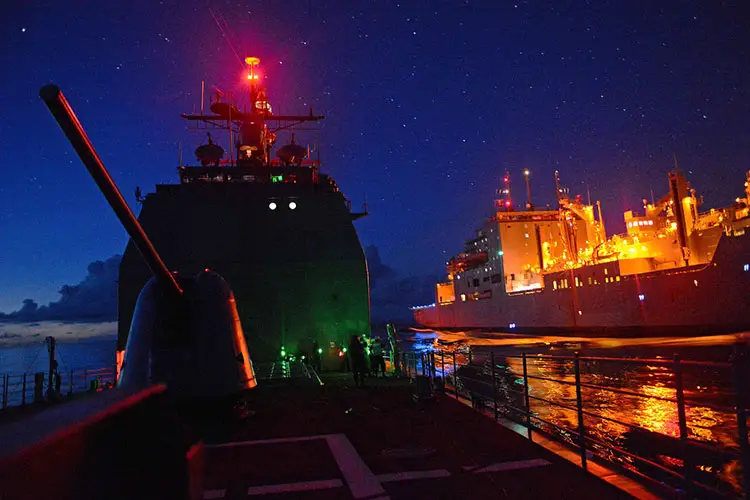
If you drive a car or even ride a bicycle, you might be well aware of the necessity of lighting systems (though in the second case the word ‘system’ doesn’t quite apply) for the safety of you and the people around you. The thing applies just as well for ships. But since they are much larger than a car, the lighting system or navigation lights on ships is a little bit more complicated as well. Marine navigation lighting is also one of the most critical aspects of nautical studies.
It is mandatory for boats of all sizes to have a navigation system . This is to make sure that the chances of any significant accident are minimized. The United States introduced the system in 1838, and the United Kingdom followed suit. Before being internationally adopted in 1897 suitable guidelines were established by the International Maritime Conference which was established in 1889. Three colors were chosen that were to be used for the light colors. They were red, green and white. This was based on a set of rules specified by the US and are followed around the world to this date.
This article discusses the different rules and regulations of using navigation lights, their importance, and also some basic marine navigation lighting systems along with their positions and ranges.
Marine Navigational Lights, Rules and Regulations
A standard pattern of marine navigation lighting is followed for the identification of both the vessel as well as the IALA buoyage system at night. If you are required to move from sea to a channel you need to have a list of all the IALA as well as the other fixed navigational lights that are visible on entering the channel. This includes distant lighthouses as well.
If you also make a note of the inland features like the radio and television transmitter masts it will benefit you because they act as good navigational aids due to their height and warning lights.
The helmsman should not be using any bright light source in the cockpit area and should rather take the aid of red lights and very dim white lights in the galley and navigation area. This is because he needs to preserve his night vision so that he can accurately interpret both the buoyage marine navigation lights as well as the boat navigation lights of other vessels.
The nautical almanacs contain the details of each and every visible maritime light signal coming from navigational markers that are both inside and outside the channel.
All the details about any particular light can be found in a published list or on a marine navigational lights chart: its color, period, and in some cases even the elevation and range of the beacon. Use the chart to keep a tag on the lights you are passing by putting a tick mark on the lights that you are about to pass and as the boat sails past, the tick is checked.
You will get two visual clues to figure out how far you are away from a buoy. The light will elevate from the horizon at 0.5 nm and at about 200m, the light will reflect on the surface.
Position of Boat Navigation Lights
Most of the variations that can be found in the different vessels can be read about in most almanacs. At the very basic level, a vessel needs to show a red light to port and green light to starboard. Depending on the size of the vessel, one or more colored or white lights are used as well.
For vessels that are 12 ft in length or shorter, the navigation lights must be visible from a range of one nautical mile and for the ones that are longer than 12 meters the required visibility range is 2 nautical miles. From 5 degrees above to 5 degrees below the horizontal happens to be the required minimum intensity in a vertical sector.
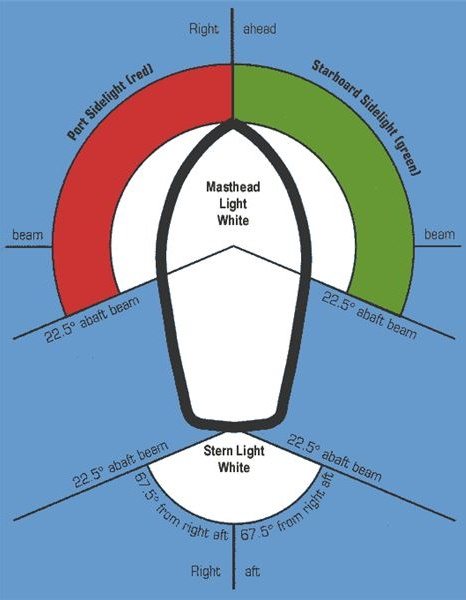
International Navigation Rules state that the boat navigation lights should be placed above the uppermost continuous deck. In case separate fixtures are used for the red and green sidelights, the masthead or all-round white light is placed as close as possible to the vessel’s fore and aft centerline. The masthead or all-around light needs to be positioned at least 1 m or 3.3 ft above the sidelights.
Following are the basic positions of navigational lights. We will discuss the same in greater detail ahead.
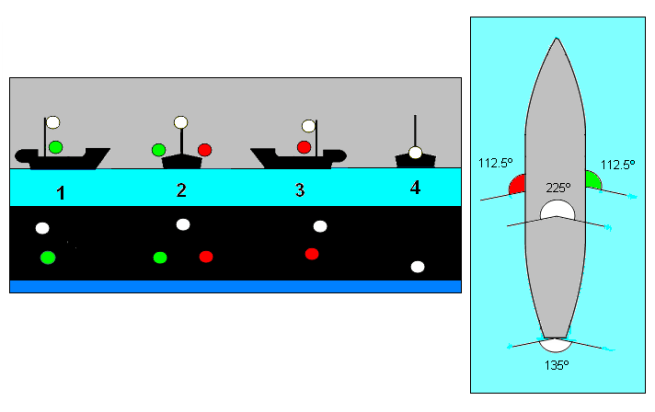
Also read: What Is A Marine Sextant?
Boat Navigation Light Regulations
Several rules and specifications are related to the type, size, layout, arc, and distance of visibility of boat navigation lights used by all vessel types which are collectively known as the International Regulations for Preventing Collisions at Sea or COLREGs . The navigational lights used are known as ‘COLREG lights and shapes. A boat might be anchored or underway, under sail or power, or fishing or trawling. These various situations can be communicated through multiple combinations of boat navigational lights.
In addition to the primary navigation lights, vessels may also display one or more steaming lights. These lights are very useful for it gives details about the various aspects of the ship like whether it is in the sail or under power, the direction in which it is going and, in some cases, even the size of the vessel. If a ship is engaged in a specific task that might involve certain restrictions, that too can be indicated with some extra boat lights.
Always maintain the lighting system and display the correct navigation light combination to make other vessels in the vicinity aware of your course and state as to whether your vessel is under power or not. If you follow this a considerable amount lowers the chances of a collision. Here is a list that you might use to familiarise yourself with the basics of the lighting system.
- Basic Navigation Light White Light : Small dinghies that are 7m or less in size are required to carry a torch having a white light that can be flashed when needed.
- All-Round White Light: An all-round white light is expected to be displayed by a small boat, up to 7ft long that is under power and can go beyond 7 knots of speed. This light must be visible at an angle of 360 degrees and from two miles away. An all-around white light is also used when the boat or vessel is at anchor but not at a designated anchoring area. This is to make sure that the ship is visible to all the nearby ships to avoid any accidents.
- Stern and Combined Side Lights : A stern light is a white light that is installed at the end of a boat. A vessel that is over 7 m or 23 ft in length is expected to show red and green sidelights when sailing. Each of these lights needs to cover an arc of 112.5°. The sidelights may be combined in one lantern at the bow when below 25 m or 65 ft. The white stern light can be seen over an arc of 135°. These lights need to be visible from a distance of a mile and need to be placed 39 inches below all white lights for boats of lengths equal to or less than 12 ft.
- Masthead Light : A combination of sidelight and stern light in a tricolor combination may be used sailing yachts of heights 20 m or lower. A masthead light is required by vessels of lengths between 39.4 ft and 65.6 ft. It is placed in the masthead whose height provides excellent visibility. Still, stern lights and sidelights should be fitted separately in case of or use under power along with steaming light. This kind of light needs to be visible across an angle of 225 degrees and from a minimum distance of 2 miles.
- Separate Lights : The displaying of the tricolor masthead light is not allowed in the case of yachts that are longer than 20 m or 65 ft. Instead, they use them separately. Often on large sailing vessels, these all-around, red over green lights are present. These red and green sidelights need to be visible from a distance of one mile and across an angle of 112.5 degrees.
- Steaming Lights Combined Lights : A combination of the masthead and stern light are used in the case of power crafts that are less than 20 m or 65 ft in length. The arrangement is present at the bow.
- Single Steaming Light : Visible over a 225 degrees arc, a masthead steaming light is used by power-driven vessels that are up to 50 m or 160 ft long. Separate stern lights and sidelights are used in case of a length exceeding 20 m or 65 ft.
- Two Steaming Lights: Power-driven vessels that span over 50 m or 160 ft in length display two masthead steaming lights. The forward light placed lower than the aft light with both of them being visible over an arc of 225° with the sidelights and separate stern light.
The area of the nautical lighting system is a precise business and requires some amount of study and a good deal of responsibility. It is because its application forms a core element in safe marine navigation.
Similar Posts

The Exxon Valdez Oil Spill Incident
Exxon Valdez oil spill was one of the worst accidents involving ocean oil spill. Today, we will uncover the true story behind it. The indispensability of oil in our day-to-day lives is unquestionable. The number of industries that are heavily reliant on oil as their source of fuel is vast. But what comes as a…

13 Major Oil Spills Of The Maritime World
An oil spill is the release of oil into the environment. Spilling of crude oil or any oil distilled product ( like gasoline, kerosene, diesel fuels, Stoddard solvent, hydraulic oils, lubricating oils) pollute the surface of the land, air, and water environment An oil spill is a kind of environmental pollution. Oil spill affects marine…

Ancient Seaports of India
It may come as a surprise to many people that India has a rich history of shipbuilding and Indians were quite accomplished seafarers. This obviously means that India also had many seaports in the past. Here is the list of ancient seaports of India. All of these ports were a hub of trade and commerce…
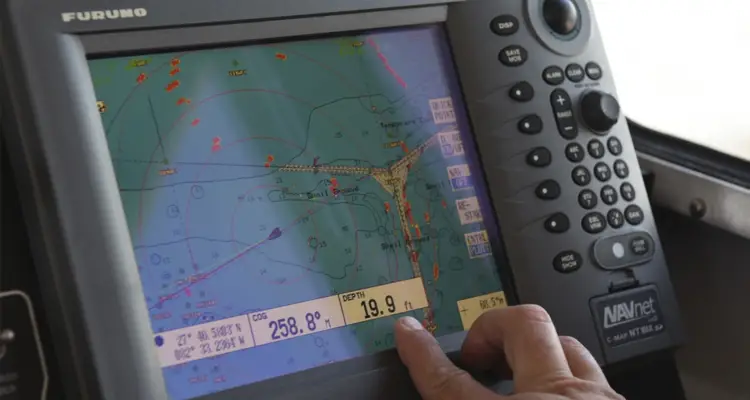
Automatic Identification System
Modern-day ships are equipped with several modern equipment and safety measures to ensure a smooth and successful voyage. These new techniques have emerged and evolved from years and years of study, research and experimenting. One such system is the Automatic Identification System or AIS. This article discusses the meaning of this term, the purpose and…

What Are Houseboats?
What Is A Houseboat? A houseboat as the name suggests is a boat that is constructed or modified to be used as a home. They are a result of a unique combination of housing and boating and are used for residential or recreational purposes. They are used as an alternate residency in many parts of…
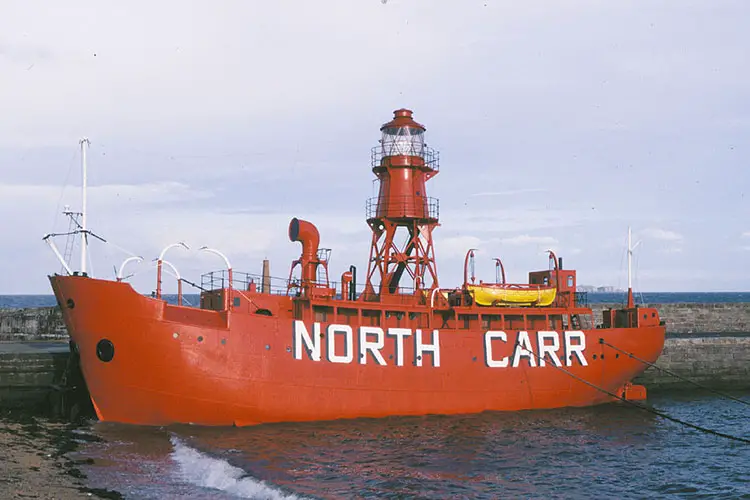
What Is A Lightship?
What is a Lightship? A lightship or a light vessel is a ship that can also operate as a lighthouse. These types of ships are used in waters that are too deep and where lighthouses cannot be constructed. Lightships play an important role in assisting other ships to navigate through waters. A lighthouse is a…
Leave a Reply Cancel reply
Your email address will not be published. Required fields are marked *
Save my name, email, and website in this browser for the next time I comment.
This website uses cookies to improve your experience. We'll assume you're ok with this, but you can opt-out if you wish. Read More

Please verify you are a human
Access to this page has been denied because we believe you are using automation tools to browse the website.
This may happen as a result of the following:
- Javascript is disabled or blocked by an extension (ad blockers for example)
- Your browser does not support cookies
Please make sure that Javascript and cookies are enabled on your browser and that you are not blocking them from loading.
Reference ID: a9ee590c-e49e-11ee-b098-00638cbea314
Powered by PerimeterX , Inc.
- Pontoon Boats
- Personal Watercraft
- nauticalknowhow
- Nautical Knots
- Tools and Calculators
Understanding Boat Navigation Lights
Boat navigation lights are essential when you’re out on the water. They’re essential, but it’s easy to misunderstand their uses and correct placements.
If you don’t know the correct placement for your stern lights or know what type of navigation light you need on your mast, don’t worry: we’re here to help. Below, we’ve got an overview of everything you need to know about boat navigation lights: what type of navigation lights you need, where to put them, and why you need to use them.
So without further ado, let’s learn more about boat navigation lights.
What navigation lights are required on a boat?
The U.S. Coast Guard Navigation Rules, International-Inland encompasses lighting requirements for every description of watercraft. The information provided there is intended for powerboats and sailing vessels less than 20 meters. The various options are illustrated.
The U.S. Inland Rules apply inside the demarcation lines at the entrances to inlets, bays, rivers, etc. The demarcation lines are shown on coastal charts as magenta dashed lines. Once outside of the demarcation lines, International Rules apply.
Powered Vessels
Power boats less than 20 meters shall exhibit navigation lights as shown in Figure 1. (Note: 2 masthead lights are optional for vessels under 50 meters. Vessels over 50 meters will display two masthead lights.)
Vessels of less than 12 meters in length, may show the lights in either Figure 1 or Figure 2.
Powerboats less than 7 meters whose maximum speed cannot exceed 7 knots may exhibit an all-round white light, and if practicable sidelights instead of the lights prescribed above, in international waters only.
Sailing Vessels and Vessels Under Oars
Sailing vessels less than 20 meters may exhibit the navigation lights shown in Figures 3 or 4.
Another option for sailboats is to use a single combination lamp at the top of the mast as shown in Figure 5.
Sailing vessels less than 7 meters may carry an electric torch or lit lantern showing a white light to be displayed in time to prevent collision (see Figure 6 – left picture).
If possible, the lights prescribed for sailing vessels less than 20 meters should be displayed.
Vessels under oars may display the lights prescribed for sailing vessels, but if not, must have ready at hand an electric torch or lighted lantern showing a white light to be displayed in time to prevent collision (see Figure 6 – right picture).
Small boats can benefit from using a temporary LED light with a suction cup attachment if permanent fixings aren’t possible.
Shapes and Lights
To alert other vessels of conditions that may be hazardous, there are requirements to display lights at night and shapes during the day.
Anchored Vessels
Powered vessels and sailing vessels at anchor must display anchor lights. An anchor light for a boat less than 50 meters in length is an all-around white light visible for 2 miles exhibited where it can best be seen (see Figure 7).
Vessels at anchor shall exhibit forward where best seen, a ball shape (see Figure 8).
Vessels less than 7 meters are not required to display anchor lights or day shapes unless anchored in or near a narrow channel, fairway or anchorage, or where other vessels normally navigate.
Anchor lights are not required on vessels less than 20 meters, anchored in special anchorages in inland waters designated by the Secretary of Transportation.
Sailing Vessels Under Power
Vessels under sail also being propelled by machinery, must exhibit forward where best seen, a conical shape with the apex pointing down (see Figure 9).
Vessels less than 12 meters are not required to exhibit the dayshape in inland waters.
Sailing vessels operating under machinery, or under sail and machinery are considered as powered boats and must display the lights prescribed for a power-driven vessel.
Restricted Maneuverability
The Navigation Rules require vessels restricted in their ability to maneuver to display appropriate day shapes or lights. To meet this requirement, recreational vessels engaged in diving activities may exhibit a rigid replica of the international code flag “A” not less than one meter in height or at night display the navigation lights shown in Figure 10.
This requirement does not affect the use of a red and white divers flag which may be required by state or local law to mark a diver’s location. The “A” flag is a navigation signal indicating the vessel’s restricted maneuverability and does not pertain to the diver.
Navigation lights should be checked prior to departing the dock and you should always carry spare bulbs. The USCG doesn’t care if they were working when you left, only that they are working when required.
Where do navigation lights go on a boat?
The current navigation light requirements are found in the Navigation Rules, International-Inland, and in Parts 81, 84, and 89 of Title 33, Code of Federal Regulations . They’re easy to find, but many sailors and boat manufacturers do not have a good understanding of the rules governing the proper installation of navigation lights. To help clear up any misunderstandings here’s all you need to know:
Sidelights that are installed in the contour of the bow without providing a mounting surface tooled to be parallel with the fore and aft centreline of the boat are not in compliance with the Inland or International Navigation Rules. Depending on the breadth of the boat near the bow and how far aft from the vessel’s stem the lights are mounted, this shift can be more than 20 degrees in some cases. Installing the fixtures too far aft of the vessel’s stem may result in the sidelights not being visible from a position dead ahead.
Another factor in the proper installation of sidelights is that they must maintain their required minimum intensity in a vertical sector from 5 degrees above to 5 degrees below the horizontal. They must also maintain at least 60 percent of their minimum required intensity from 7.5 degrees above to 7.5 degrees below the horizontal. Installing flush-mounted sidelights, designed to be mounted to a vertical surface in the hull contour, without providing a mounting surface tooled to be vertical, shifts the vertical coverage sector. This also results in non-compliance with the Inland or International Navigation Rules.
Additionally, most of these flush-mounted sidelights are installed below the vessel’s rub rail. International Navigation Rules require that sidelights be installed above the uppermost continuous deck. Therefore, this configuration would not be in compliance with International Navigation Rules.
When separate red and green sidelight fixtures are used, the masthead light or all-round white light, whichever configuration is installed, must be located as close as practical to the vessel’s fore and aft centerline. For vessels less than 12 meters in length, the masthead light or round lights may be displaced from the fore and aft centerline providing that the sidelights are contained within a common fixture and mounted on the vessel’s fore and aft centerline. The masthead or round lights must be installed at least one meter (3.3 ft.) above the sidelights.
Which navigation lights are you required to display when anchoring your boat for the night?
Boating at night (or in reduced visibility) can present some special challenges. Not only is your depth perception lessened, but bright lights on the shore can also cast misleading reflections on the water and if you wear glasses, or worse yet bifocals, you simply don’t see as well at night as you do during the day.
It is not only important that you be able to identify other vessels operating in your proximity, it is equally important that other vessels see you. Most recreational vessels are less than 30 feet in length and, according to the Rules of the Road, shall be equipped with navigation lights.
These lights not only have a certain arc through which they can be seen but must be seen from a minimum distance. The following lighting requirements are for recreational vessels less than 12 meters in length. (approximately 39.4′)
The arc of the lights and color allows you to determine the direction a boat is moving. How good are your boat’s lights? You should test them to check your nighttime visibility, or you might land yourself in hot water with the Coast Guard.
Whether on a trailer or at the marina, switch on your lights and see how well they can be seen. Walk away from the boat or row away, if you are at anchor or at a mooring, and see how visible the lights are as you move further away. How easy are they to see against the background of lights onshore?
Does your stern light shine dead astern over the required 135º arc or does it shine to one side or up or down? Can it be seen from the required 2 miles and why is that important? As an example, let’s say that your stern lights can only be seen for 1/2 mile. You are underway at 8 knots and a large ship is approaching at 15 knots. The ship is only 4 minutes away from a collision with you. By the time the ship “might” see you, identify the light, and decide on how to move, it is too late. A ship traveling at 15 knots may take miles to stop.
Look at the stern lights again, as you move from the stern toward the bow, does the stern light “disappear” as the sidelight “appears”? The stern light should disappear and sidelight appear at 22.5º abaft the beam. If you don’t see the green starboard sidelight or the red port side light when the stern light disappears there is a problem with the arc of one or all these lights. This means that if another boat were approaching you at the angle where no lights are seen there is an increased risk of collision.
If both the stern lights and side lights are seen brightly at the same time you still have a problem. A boat approaching won’t know whether they are overtaking or crossing and whether they should give-way or stand-on.
You should also check to make sure that your masthead light disappears at the same time each side lights disappear and they both disappear when the stern light appears.
Check your sidelights from dead ahead. You should see both red and green. However, by moving toward one side just 1-3º you should then see only one light. If you still see two lights, an approaching boat won’t be able to tell which direction you’re are going.
It is very important to be seen from a distance but also for an approaching boat to be able to determine your direction of travel.
When boating at night remember the following: “When two lights you see ahead, turn your helm and show your red”.
About Chris
Outdoors, I’m in my element, especially in the water. I know the importance of being geared up for anything. I do the deep digital dive, researching gear, boats and knowhow and love keeping my readership at the helm of their passions.
Categories : nauticalknowhow
Robert Hogward on September 12, 2021
Thanks for writing this post. I can either place them on the exterior or interior for decorations. Placing them on the exterior side is helpful when I go fishing and indulging in other night activities in the water.
Dalton Bourne on July 26, 2022
We love the lights! We put lights from Seaponer on my Jon boat right above the water line and use them for night fishing! The amount of brightness it offers is an assurance of my boat’s being seen clearly during the night. At the same time, the LED lights don’t consume too much energy, leading to a life span of up to 50,000 hours.
Leave a Reply Cancel reply
Your email address will not be published. Required fields are marked *
Save my name, email, and website in this browser for the next time I comment.
More in nauticalknowhow

How to Tie a Boat to a Dock

How to Clean a Boat Cover

Everything You Need to Know About Your Boat’s Bilge Pump

4 Ways to Tie Your Boat Shoes

The People’s Poncho Review and Ratings

Oru Lake Kayak Review

What Is A Gunwale?

131 of the Best Hawaiian Boat Names

167 Patriotic Boat Names
About boatsafe.
Established in 1998, BoatSafe is your independent guide into the world of boating, fishing, and watersports. We provide expert insights and detailed guides to help you find products tailored to your needs and budget.
Contact Boatsafe
- Address: 4021 West Walnut Street. Rogers, AR 72756
- Phone: (479)339-4795
- Email: [email protected]
Site Navigation
- How We Test
- Corrections Policy
- Privacy Policy
- Terms & Conditions
- Editorial Policy
- Affiliate Disclosure
Our Reviews

All content is © Copyright 2024. All rights reserved.
Marine Navigation Lights: A Boater’s Guide
As a seasoned boater or a seafaring enthusiast, your understanding of marine navigation lights can make a vast difference in your nocturnal and low-visibility voyages. Precision in navigating the open waters lies not only in skill but also in the silent language of luminescence, communicated through the boat navigation lights . Whether adrift at twilight or in the embrace of a foggy morning, these lights play a pivotal role in your safety and compliance on the water.
Navigating the waterways, you’re mandated to display red and green sidelights that reveal your port and starboard orientations, accompanied by distinctive white lights that cut through the darkness or fog. These sentinels of the sea become your voice in the silence, your identifiers when all else fades away. Beyond mere functionality, having a readily available flashlight can be a beacon of hope in unexpected situations.
Dive into the essentials of maritime navigation lights , where size, propulsion, and water category form a trinity of factors shaping specific lighting requisites. Let’s illuminate your journey with the beacon of knowledge, ensuring every nautical mile you chart adheres to both safety measures and legal benchmarks.
A close-up illustration of the different types of marine navigation lights used on boats, with labels for each light and their meaning. The image should be set against a dark blue background to convey the feeling of being at sea. The lights should be colorful and bright, with the white light of the masthead visible at the top of the image, and the red and green sidelights visible at the sides. A small anchor symbol can be placed somewhere in the image to further emphasize that this is a guide for boaters.
Key Takeaways
- Recognize the critical role of marine navigation lights in ensuring your voyage remains safe and law-abiding.
- Master the art of signaling your vessel’s position and direction through proper light display.
- Equip yourself with the knowledge of varying light requirements according to your boat’s specifications.
- Keep a flashlight onboard as a part of your navigational toolkit for emergency light failures.
- Remember that it’s your responsibility as a captain to ensure your navigation lights are in working order and meet the legal standards for the waters you traverse.
The Importance of Boat Navigation Lights
As night falls or when a thick fog envelopes the waterways, the role of marine safety lights transitions from an accessory to a critical safety feature. These navigation lights for boats are more than just functional equipment; they are your vessel’s voice in the darkness, conveying crucial information and preventing mishaps in conditions where visibility is compromised.
You can read more about Essential Tools to Have in a Boat for Safety
Ensuring Visibility in Restricted Conditions
When visibility is poor, be it due to inclement weather or the absence of daylight, marine safety lights serve as your primary means of making your presence known to other seafarers. These lights help you to see and, more importantly, to be seen, which is fundamental to safe navigation and avoiding potential dangers that may not be visible to the naked eye.
Preventing Collisions at Sea
Comprehending the arrangement and color of navigation lights for boats enables you to quickly gauge the direction, size, and type of the vessels around you. By providing clues about which way a boat is heading, these lights are instrumental in making split-second decisions to avert accidents and enhance maritime security for all.
This Blog covers: Essential Tips for Collision Avoidance on the Water
Understanding the Legal Obligations
There’s a legal side to lighting up as well. Skippers must adhere to stringent regulations set forth by the US Coast Guard, among others, to outfit their vessels with the proper lights. These guidelines ensure that every boat, irrespective of its route or purpose, complies to a standard that pivots on collective safety.
It’s not just about having lights onboard; it’s about ensuring they are of the accepted color intensity and strategically placed for optimal effect. It’s your responsibility as a boat owner to illuminate the seascape, not just for your own safety, but for the well-being of your entire seafaring community.
Understanding Color, Position, and Purpose
When it comes to marine navigation lighting , every color and position communicates vital information for safe passage and collision avoidance. As a boater, understanding the significance of each vessel navigation light will not only keep you compliant with maritime laws but can also be the key to a safe return to port.
Marine navigation lights are multi-colored visual cues that reveal important attributes of the vessel, such as its size, the direction of travel, and the activities it may be engaging in. For instance, white lights typically serve as stern lights or all-around lights, while red and green lights denote the port and starboard sides of a boat, respectively. Different light configurations help mariners to determine a vessel’s aspect and orientation, a fundamental factor in making informed decisions at sea.
The specific placement of these lights is critical to comply with the required angles of visibility and ensure they are visible at the required distances. To illustrate, sidelights must be visible at an arc of 112.5 degrees from the bow to just aft of the beam on the respective sides. In contrast, stern lights have an arc of visibility of 135 degrees, and all-around lights showcase 360 degrees.
Proper positioning ensures that irrespective of your vessel’s angle due to wave action, payload, or maneuvering, your navigation lights remain visible to other mariners, signaling your intentions and position.
A thorough grasp of these guidelines ensures you not only navigate the waters safely but also respect the navigational space of fellow mariners, creating a safer environment for all. As every voyage begins and ends with safety considerations, the color, position, and purpose of marine navigation lighting serve as the foundation of maritime protocol.
Specific Light Requirements for Different Boats
As you navigate the waters, it’s essential to understand that marine LED navigation lights and marine signal lights vary depending on your vessel’s size and type. Let’s dive into the guidelines that will keep you compliant and safe on the open sea.
Lights for Powered Vessels Under 12 Meters
Small powered vessels have a unique set of requirements to ensure they are visible at sea. Operated at night or during times of reduced visibility, these boats must exhibit an all-around white light and separate red and green sidelights to signal their presence to other mariners effectively.
Navigation Light Specifications for Sailing Vessels
Sailboats under 12 meters must adhere to similar lighting specifications with slight variations suitable for their operation. Proper lighting ensures that they are detected by other watercraft in their vicinity, promoting safety for all.
What is a Navigation light? Click Here to read about it in Wikipedia
Advanced Lighting for Vessels Over 20 Meters
Larger vessels have more complex lighting systems to reflect their size and the distance from which they need to be seen. Ensuring these sophisticated lighting setups are correctly utilized is a central aspect of maritime safety for these giants of the seas.
Whether you’re captaining a nimble powerboat, gracefully sailing, or charting the course for a larger vessel, the correct marine led navigation lights and marine signal lights are key to your journey. Equip your vessel with the right lights, and sail with the confidence that comes from knowing you are both seen and safe.
Marine Navigation Lights and the Rules of the Road
As you voyage across the waters, your vessel’s compliance with maritime safety regulations is paramount. Among the universals of these regulations are the maritime navigation lights , an integral aspect of marine lighting solutions that align with the ‘Rules of the Road’. The importance of these rules cannot be underscored enough—they are designed to ensure the safety of all maritime traffic by preventing collisions and confusion.
By following these rules, you ensure that your vessel’s lights are visible in all the necessary conditions, such as when your boat is underway or heeling. This visibility is crucial as it directly correlates with the ability of other vessels to make informed decisions in the open water. Let’s dive into some of these Requirements:
- Navigation lights must be operational from sunset to sunrise.
- Lights should also be deployed during periods of restricted visibility, such as fog or heavy rain.
- The lights configured on your vessel should not impair the visibility of other boats or be mistaken for other types of navigation lights.
- Maintaining proper lookout must not be hampered by the lights.
Each light on your vessel serves a distinct purpose, indicating not only your boat’s position but also your direction and status. To help you understand these better, here’s a breakdown:
“Comprehending and implementing the correct use of marine lighting solutions is more than a legal mandate; it is a commitment to safeguarding lives at sea.”
Interpreting what each light signifies about a vessel’s size, direction, and operation is a critical skill. When all mariners comply with the established rules, the sea becomes a domain where safety and navigational proficiency reign supreme.
Your due diligence in navigating with the proper lights not only signifies adept compliance but also reflects a broad understanding of maritime safety protocols. Remember, being visible is not merely about being seen; it’s about communicating clearly with other seafarers to share the waterways safely and responsibly.
Installation and Positioning of Marine Lighting Solutions
As a vessel owner, ensuring your craft’s visibility with the proper navigation lights for boats is not only a safety measure but a regulatory requirement. This goes beyond just picking out the brightest lights – it involves strategic placement and adherence to height specifications to optimize the effectiveness of your marine lighting solutions .
Placement for Optimal Visibility
Correct placement of navigation lights is crucial for optimal visibility. Position your lights so they are unobstructed from view, with sidelights mounted on the bow and masthead lights elevated for clear signaling. Consider the angles of visibility; side lights should have an unbroken arc of illumination to communicate your boat’s position accurately to other vessels.
Height Requirements for Different Lights
Your boat’s lighting configuration should follow specific height requirements. Masthead lights, for instance, must be higher than the sidelights, particularly on sailing vessels. The US Coast Guard outlines these requirements in detail, which correspond with the type and size of the watercraft you’re operating.
Considerations for Portable Navigation Lights
Small or manually powered vessels might not have a permanent lighting setup, making portable navigation lights a flexible option. These should be mounted in a manner that maximizes visibility: at the bow for sidelights and at the highest accessible point towards the stern for the all-around white light. Even with portability, these lights must comply with the same visibility arcs as fixed lights for consistency and safety.
The Role of LED in Marine Navigation Lights
Transitioning to marine LED navigation lights is a game-changer for boaters who prioritize efficiency and dependability in their marine lighting solutions . LEDs provide a multitude of benefits over traditional lighting methods, ensuring that your vessel is not only compliant but also equipped with the latest in lighting technology.
The switch to LEDs isn’t just about following a trend; it’s about embracing a lighting system that stands out for its longevity, lower power needs, and robust performance – qualities that every seafarer values highly. Consider the following advantages of LED lights for your marine vessel:
- Durability : LEDs are built to last, providing a solid return on investment with their extended lifespan.
- Energy Efficiency : Their minimal power consumption translates to longer battery life, an essential feature when out on open water.
- Superior Visibility : Offering bright and clear illumination, LEDs ensure that your presence is signaled effectively.
- Reduced Maintenance : With fewer replacements needed, there is lesser hassle and more time to enjoy your maritime experience.
- Eco-Friendly Option : LED lights are a step toward greener boating, conserving energy and reducing waste.
Pairing these benefits with the compatibility of LEDs with modern electronics, your boating experience becomes not just safer but also more advanced. Gone are the days when navigating through the dusk was a taxing process; LED lighting solutions offer a state-of-the-art system designed to ease the way you traverse the waters.
With the information provided, you can see that opting for marine LED navigation lights is an intelligent move towards a more reliable and economical approach to seafaring. Whether it’s a small fishing boat or a large yacht, lighting is critical for safety and communication, and LEDs are paving the way for a brighter and more sustainable future on the waters.
How to Interpret Marine Signal Lights Effectively
Mastering the language of marine signal lights is essential for the safe navigation of our vast waterways. As you take the helm under the cover of darkness or the veil of fog, knowing how to read the messages conveyed by marine navigation lighting can make all the difference in maneuvering confidently and avoiding potential dangers.
Decoding Lights from Other Vessels
Each light pattern you see serves as a visual code, representing the type and activity of nearby vessels. A single white light might indicate a small, anchored craft, while a set of gleaming red and green lights will tell you about the direction a neighboring boat is facing—green for starboard and red for port. Understanding these signals allows you to anticipate the movements of others and react appropriately.
Identifying Lights Denoting Special Activities
Activities like fishing or towing require vessels to display specific light configurations, a critical cue for you to make informed decisions. A vessel engaged in fishing may show a green light above a white light, asking for extra space for their nets. Recognizing this early gives you a chance to steer clear and avoid getting tangled up.
Navigating Around Vessels with Diving Lights
Cautious navigation around boats involved in diving activities is just as vital. The sight of a red, white, and red light sequence from the masthead means divers are in the water, and maintaining a respectful distance is a must. This knowledge is your safeguard against disturbing their underwater endeavors and maintaining safety.
By being fluent in the visual language of signal lights, you enhance your night-time sailing experience and contribute to the collective effort in preventing accidents on the water.
Maintaining and Troubleshooting Your Vessel Navigation Lights
As a prudent mariner, establishing routine marine navigation lights maintenance is imperative to guarantee that these critical safety features function properly when you’re out on the water. It’s indispensable to troubleshoot boat navigation lights regularly to identify any potential issues before setting sail. Let’s consider a comprehensive checklist that you should routinely follow to ensure your navigation lights are in peak condition.
Before departing, inspect each light for signs of wear or damage and test them to confirm they’re operational. If you discover any lights are not functioning correctly, apply these common troubleshooting steps:
- Check the light bulb for functionality – replace if necessary.
- Examine the wiring and connections for corrosion or loose ends.
- Ensure the power source or battery is fully charged and not depleted.
Moreover, maintaining an inventory of spare parts onboard can be a lifesaver during unexpected circumstances. The table below provides a detailed overview of essential spares that every boat owner should consider carrying:
Keep in mind that regular cleaning of light lenses and housings should form part of your maintenance routine, as salt, dirt, and grime can significantly diminish light intensity and visibility. Use a mild detergent and soft cloth to prevent scratching or damage to the lenses. Adhering to these practices will ensure that your vessel remains compliant with maritime regulations and, more importantly, safe on the waters.
Marine Navigation Lights for Safe Anchoring Practices
As a conscientious boater, understanding the importance of proper anchor lighting is key to maintaining safety standards while at sea. It’s essential to be aware that when you anchor your vessel, you are required by the United States Coast Guard (USCG) to deploy marine navigation lights that are visible and clear in their messaging. These anchor lights for boats play a pivotal role in preventing accidents by signaling your anchored presence to passing maritime traffic.
Anchor Lighting Requirements
The USCG stipulates a clear directive for boats at anchor: an all-around white light must be prominently displayed and visible from a minimum distance of two nautical miles. This lighting serves as a beacon to other vessels, reducing the danger of unforeseen collisions and ensuring that your boat is visible even in conditions with limited natural light.
Such anchor lighting is non-negotiable in terms of safety, and compliance with this regulation is not only a matter of legal requirement but also a testament to responsible boating practices. Whether you’re anchoring overnight or momentarily, always ensure that your anchor light is operational and meets the required visibility range. By doing so, you contribute to the overall safety of not just your own boat, but also that of surrounding marine traffic.
Choosing the Right Anchor Light for Visibility
Selecting the proper anchor lighting for your boat involves several considerations. Firstly, you need to ensure that the light’s intensity is strong enough to satisfy the two-nautical-mile visibility requirement. Height also plays a critical role; the higher the elevation of the light, the greater its range of visibility, which contributes significantly to safe anchoring practices, especially in busy or poorly lit maritime areas.
When you’re in the market for marine navigation lights , it might be worthwhile to invest in LED technology. LEDs provide brighter illumination, consume less power, and have a longer lifespan than traditional bulbs, making them an ideal choice for anchor lighting for boats . Remember, it’s not just about meeting regulatory standards—it’s about maximizing safety and visibility while you’re at rest on the water.
As we’ve navigated through the essential aspects of marine navigation lights in this boater’s guide, it’s clear that your awareness and compliance with marine safety norms and legal requirements is not just a matter of following the rules—it’s a commitment to the collective well-being of the maritime community. Proper installation, vigilant maintenance, and the correct use of these vital lights ensure that your time on the water is both enjoyable and safe.
Understanding the nuances of how marine navigation lights function and their role in preventing mishaps is a fundamental part of safe boating practices. Whether you’re managing a small dinghy or captaining a larger vessel, the principles remain the same: be seen and know how to read the signals of others. With the advancement of LED technology, these imperatives are now easier to meet, rendering a more reliable and energy-efficient means to signal your presence on the vast waters.
In summary, let’s keep in mind that adhering to the guidelines for marine navigation lights is not merely about avoiding fines or sanctions; it’s about ensuring that every journey you undertake is marked by safety and a deep-seated respect for the sea and your fellow boaters. Paying close attention to these details means that you’re not only protecting yourself and your passengers but also contributing to the broader culture of responsible boating.
How Important Are Marine Navigation Lights for Boating Safety?
Marine navigation lights are crucial for boating safety, especially when dealing with difficult conditions. These lights help vessels avoid collisions and navigate safely through waterways. Having proper boating safety skills for difficult conditions , including understanding and using navigation lights, is essential for all boaters to ensure a safe and enjoyable experience.
What are the basic marine navigation lights required on a boat?
At a minimum, boats must have red and green sidelights to indicate port (left) and starboard (right) sides, as well as one or more white lights for overall visibility. The specific configuration depends on the type and size of the vessel.
Why are boat navigation lights critical during restricted visibility?
Boat navigation lights are critical during restricted visibility, such as night, fog, or heavy overcast conditions, to ensure that you can see other vessels and they can see you, thus reducing the risk of collisions.
Are there different lighting requirements for powered vessels and sailing vessels?
Yes, powered vessels under 12 meters require an all-around white light and red and green sidelights, while sailing vessels can display the same sidelights with either a stern light or a tricolored masthead light. Larger vessels have additional requirements.
What is the main purpose of different colored marine navigation lights?
Different colored lights convey important information about a vessel’s size, type, and activity. For example, green and red lights indicate the starboard and port sides of a boat, while white lights illustrate the stern or surrounding area of the boat, providing visibility to others.
How do you ensure compliance with maritime navigation light regulations?
A boater must familiarize themselves with the US Coast Guard regulations and any additional state or local requirements to ensure that the boat has the right lights that are working, properly placed, and lit during mandated times.
What advantages do LED marine navigation lights offer?
LED marine navigation lights offer durability, energy efficiency, and a longer service life. They provide bright, clear visibility and are a more environmentally friendly option due to their lower power consumption and reduced maintenance.
How can you interpret the signals from marine signal lights?
Interpreting marine signal lights involves recognizing different light colors and configurations to determine other vessels’ activities, such as fishing or diving, which helps in making safe maneuvering decisions.
What should be done to maintain and troubleshoot vessel navigation lights?
Regular inspections, cleaning, and testing must be conducted to ensure that navigation lights are in working order. Carrying spare bulbs and batteries and addressing any electrical issues promptly are part of proper maintenance and troubleshooting.
What type of lighting is required when anchoring a boat?
When anchoring, all boats must display an all-around white light that can be seen from a minimum of two nautical miles to alert other vessels of the anchored boat’s location.
How can you choose the right anchor light for proper visibility?
The right anchor light should have sufficient intensity and elevation to be visible from at least two nautical miles and must be situated in a position where it isn’t obstructed by the boat’s superstructure or other equipment.
My topics range from best practices for managing operations to product reviews. I believe that by sharing my knowledge and expertise with others in the industry, we can all learn from each other and improve our businesses together.
Automated page speed optimizations for fast site performance
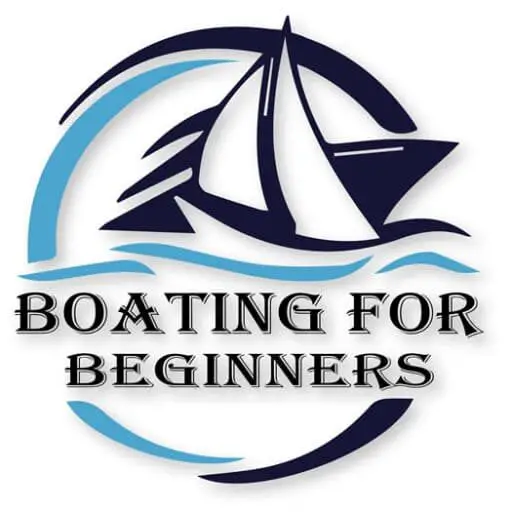
Boat Lighting – Complete Guide to Navigation Lights
I was sitting in the garage the other day admiring my boat when I noticed the green navigation light on the side of the hull, and it dawned on me that I haven’t had the boat out after sunset yet. It also got me wondering about the different places I’d like to travel this summer and what it would be like to navigate in the dark if I had to.
In addition to the legally required lights, I highly recommend having a marine waterproof spotlight in your boat at all times ( this is the one I prefer, which you can buy on Amazon with tons of good reviews ). The little headlight on a boat is nowhere near bright enough to safely navigate if you get caught on the water at night. Trust me, it can save you thousands in boat repairs and a dangerous situation.
I wanted to make sure that I fully understood everything there was to know about navigation lights, so I did some online research. I’ve put together a complete guide of the information I found online talking about the different navigation lights and what I needed to know about them.
What Are Navigation Lights On a Boat?
Boats require specific lighting configuration when operating between sunset and sunrise, or at times when visibility is restricted such as when it’s raining or foggy. Navigation lights are used to help other boaters see you when visibility is reduced, and it allows you also to see the other boaters to avoid collisions.
Navigation lights are also used to communicate with the other boats sharing the water. For example, the navigation lights can tell another boater, what size your vessel is, and in which direction you are heading. This information can be used by the boat caption to determine what the appropriate course of action would be as you approach each other.
By law, the navigation lights come in specific colors; white, red, and green. Even the arc of the illuminated light, the range of visibility, and the location is all specific to what type of vessel you are operating.
Do not assume that your boat came with the appropriate lighting or equipment from the factory or showroom. It is your responsibility to make sure that your boat has the proper navigation lighting configuration before you head out on the water.
What Type Of Boats Requires Navigation Lights?
Basically, in a nutshell, all boats require navigation lights if you’ll be operating them between sunset and sunrise, or whenever visibility is reduced.
This goes for the following types of vessels:
- Motorized vessels
- Non-motorized vessels
- Sailing vessels (Operating under sails)
- Sailing vessels (Operating under motor power)
- Vessels engaged in fishing
- Vessels engaged in trawling
- Towing vessels
- Anchored vessels
- Human-powered vessels such as Rowboats (Kayaks and canoes)
What Lights Are Required On a Boat?
Boats are required to have navigation lights. Navigation lights are required whenever you are operating your vessel between sunset and sunrise, or during any other times when your visibility is restricted from elements such as fog or rain.
The type of lights required depends on the length of your vessel as well as if it’s a powered or non-powered vessel. But in general, all navigation lighting systems will consist of red and green sidelights, as well as one or more white lights. A red sidelight indicates the port side of the vessel, while a green light shows the starboard side of the vessel. The white light in most cases is called an all-around light, which means it can be seen from any angle by other boaters.
Another type of navigation light is a yellow light. A yellow light is not very common to see, but if you do happen to see one, it would mean that a lead boat is towing another boat.
It is your responsibility to make sure you have the proper navigation lighting. It is also recommended that you take spare bulbs with you. The USCG doesn’t care if the lights were working when you left, they only care that the lights are not working when they are required.
Lights Required For Power Vessels Underway:
A powered vessel includes all motorized boats, including sailboats that use a motor.
Vessel length: Under 12 meters (39.4 FT.) Lighting requirement:
- One all-around white light that is visible at 360 degrees, and can be seen from two miles away. The all-around white light must be mounted at least 39 inches above the side lights.
- A pair of red and green sidelights that are visible 112.5 degrees and can be seen at least one mile away.
Vessel length: 12 meters to 20 meters (39.4 FT. to 65.6 FT.) Lighting requirement:
- A white masthead light located at the front of the boat, pointing in the direction you are traveling. This must be visible at 225 degrees and from two miles away. The masthead light must be positioned at least 8 feet above the gunnel.
- A white stern light located at the rear of the boat that is visible at 135 degrees and can be seen from 2 miles away.
Lights Required For Non-powered Vessels Underway:
A non-powered vessel includes sailing vessels and all other types of vessels that don’t have motors such as paddled, poled, or rowed.
Vessel length: Under 7 meters (23 FT.) Lighting requirement:
- You are required to display a white light that can be seen by other boats. White light could consist of a flashlight, torchlight, or lantern.
- If you can, it is recommended that you have an onboard 360-degree white light all-around set on the horizon, with a distance of at least two miles.
Vessel length: Over 7 meters (23 FT.) – NEED 3 IMAGES Lighting requirement:
- A pair of red and green sidelights, that are visible 112.5 degrees and can be seen at least one mile away.
- Alternatively, for sailboats of that are over 7 meters in length, they can display what is called a tricolor light A tricolor light can only be used while the vessel is underway using sails alone and never while underway by power. This light should also never be used at the same time that the regular sidelights are on. Either the tricolor light or sidelights can be displayed, but never both.
Lights Required For Vessels At Anchor (Less Than 50 Meters):
This rule applies if you are anchored away from a designated area such as a marina.
Vessel length: 12 meters to 20 meters (39.4 FT. to 65.6 FT.) Lighting requirement:
- White all-around light is required to be used so you are visible to other ships that could be in the area.
Due to variances in state boating laws/regulations, NASBLA does not provide state-specific information. You may contact your state boating office for the most accurate information. Contact information can be found here: https://www.nasbla.org/about-nasbla/boating-contacts .
Understanding The Difference Between Port And Starboard Lights
While standing on the deck and facing the front of the ship, the left side is called the Port and the right side is called the Starboard. The port is always red , while the starboard is always green .
This information is crucial to understand if you ever find yourself trying to navigate the waters at night or while your visibility is limited. For example, if you are sailing towards another vessel, you will be able to tell if that vessel is heading towards you, or if it is heading away from you based on which side the green and red lights appear to you.
If you see a red light coming towards you, that would mean the other boat is on your right, which means that boat would have the right of way. If you see a green light from an oncoming vessel than you would know that it’s on your left, which means you have the right of way.
When Should Navigation Lights Be Displayed On a Boat?
Navigation lights are required to be displayed in between sunset and sunrise, and anytime that visibility is restricted. For example, due to fog or rain.
Where Can You Buy Navigation Lights?
As discussed earlier, not all boats automatically come with the proper display of navigation lights. It is your responsibility to ensure that your boat has all of the proper equipment for your safety and the safety of others.
The prices for navigation lights will vary anywhere between $9.00 to $100.00 depending on what style and manufacturer you buy. You could even spend as much as $500.00 on some of the higher-end navigation lightings. Be sure to shop around and take a look at what is available, to ensure that you are finding the best lights, at the best prices.
Definitions
All-Round Light: White (32pt/ 360°) Masthead Light: White (20pt/ 225°) Sidelights: Red (10pt/ 112.5°) & Green (10pt/ 112.5°) Stern Light: White (12pt/ 135°)
Similar Posts
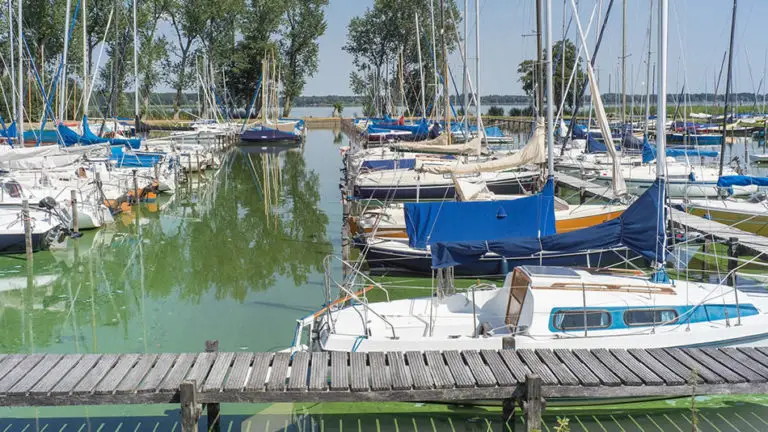
How To Get Rid of And Prevent Algae on a Boat
I have to admit; I didn’t know too much about algae until I began researching it. I figured if my son were going to be coming out on the water with me, then I’d better learn more about it and make sure it wasn’t going to be harmful to us. As it turns out, there…

Can Boats Survive Tsunamis? Everything You Should Know
Last night at dinner I was talking to my wife about the different places we could go this upcoming summer for a family vacation, and somehow the conversation turned to tsunamis. I have heard in the past that being on a boat during a tsunami is a safe place to be, but I still wanted…

Starting Boat Motor Out Of Water
I’ve heard a lot of boaters talking about how they start their inboard or outboard engine while the boat is on land so they can test the motor before they have it on the boat launch. That got me wondering how safe it could be for the engine, so I did some research. As it…
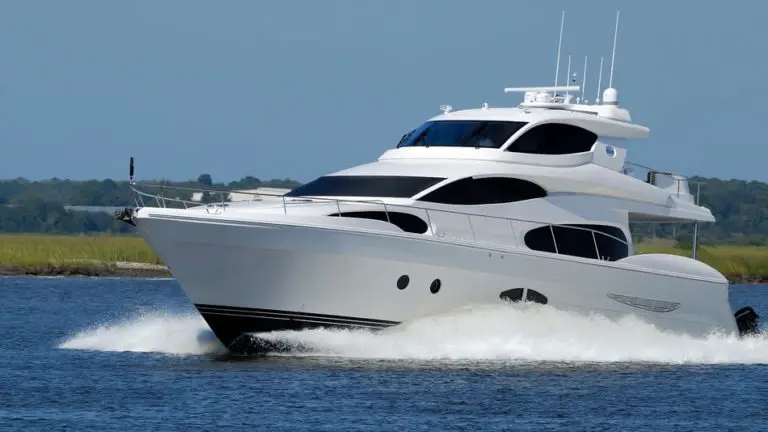
Buyer’s Guide for a First Time Boat Purchase
Our retirement dream boat is a beautiful 54′ long luxury cruiser yacht with all the bells and whistles. Powerful enough to plow through the roughest waters as we head towards the Caribbean for a few weeks. But before I can get ahead of myself with such a lavish purchase, I decided to keep things simple…

Helpful Tips For Towing a Boat
Every boat owner knows that being able to take your boat everywhere you want is a privilege and a great way to spend your time. However, there are specific rules you have to abide when you want to tow a boat. Some states require special trailer brakes especially if the boat has more than the…
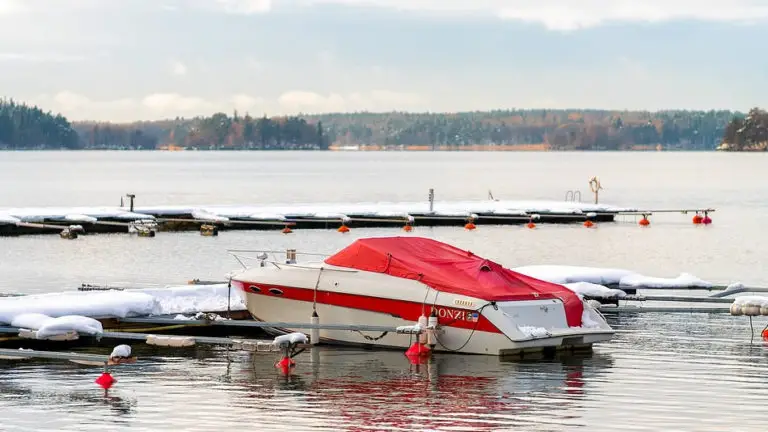
Everything You Need to Know for Winterizing a Boat
With winter right around the corner, the cold air will soon be taking over, causing temperatures to drop below freezing for half of the country. But before that happens you need to make sure that your boat is ready. Without properly winterizing your boat, you run the risk of water freezing and causing the engine…

Boat Navigation Lights: Everything You NEED to Know (2024)
In many cases, boating at night requires the use of boat navigation lights, but boaters often have many questions about them.
They often wonder when they’re needed, what the requirements are for various locations and vessels, and more.
We’re going to do a deep dive into navigation lights for boat to see what you need on your boat, and when you need to use them.
Legal Requirements
Types of navigational lights, which navigation lights are required on my boat , operators responsibility , navigation lights .
On any vessel operating on or in US waters, there is a need for the operator to display navigation lights under certain circumstances. Their purpose is to make vessels aware of each other at night or in times of generally reduced visibility. This is incredibly important during times when you may not be able to see the craft itself.
Other than visibility, marine nav lights also help boat operators determine the size, direction of travel, and even the potential activity of another boat on the water. When an operator understands the type of information each light tells them, they will be better able to determine appropriate courses of action for potential situations.
Boat running lights are divided by location and color, and each of them has specific requirements with how they must be displayed and perceived. You are the one legally responsible for displaying proper nav lights on the boat, for displaying them at the proper times, and for understanding how to read them.
The US Coast Guard ’s legal navigation light requirements include guidelines for every aspect of light usage.
Their materials start by first defining the standard daily period during which they must be used, then they detail how many of each type of light is needed as well as where they are located. Each light also has constraints regarding its visible distance and the arc over which it can be seen.
In the US, the Coast Guard says that any powered vessel that is under 39.4ft., may operate with boat nav lights in as little as two positions, an all-round light at the stern, and a set of sidelights at the bow.
Vessels that are under 164ft. must have lights displayed in four positions, a stern light, a masthead light, and boat sidelights on both the port and starboard, near the bow.
The ship navigation lights also have minimum visibility distances, depending on the size of the craft. The minimum visibility for nav lights, even for small crafts, is one mile, with requirements that other lights on larger vessels be visible for up to 3 nautical miles.
Also read: Boating Rules and Etiquette On the Water
Boat lights come in 4 types, sidelights, stern light, masthead light, and all-round light. Lights only come in white, red, and green, and all have very specific jobs.
Masthead Light
The masthead light is the white light located about ⅔ of the way up the mast, rather than at the top as you’d think. This boat bow light is required when using motor power at night. To be acceptable, the light must have an arc of 225° and needs to be seen from 2 miles away.
Large boats can have up to 3 mast lights. If your boat is shorter than 39 ft., all 2-3 white mast lights can be combined, utilizing one larger white light at the top of the mast.
Color : White ARC : 225 degrees Position : Front of boat
Port Sidelight
The boating lights located on the port side of the watercraft are red and mounted so that boats can see as they approach either head-on or from the left. This light helps tell if a boat is coming towards you or if it is pointing away. The phrase “red, right, returning” means that if you see a boat with their red navigation light on the right, they are facing your boat. The only time it is not needed is when your boat is anchored for the night .
Color : Red ARC : 122.5 degrees Position : Forward, left side
Starboard Sidelight
If you are to approach a boat from the front or right, you will see the green starboard sidelight. With an ARC of 122.5 degrees, approaching boats will be able to see yours easily.
This light helps tell you whether or not you have the right of way, which is important when it comes to keeping both you and your passengers safe. These are some of the front boat lights.
This light will often be combined with the port light, in small boat navigation lights. When out in the water, if you see the green light, that means it is safe for you to go, as you have the right of way.
Color : Green ARC : 122.5 degrees Position : Forward, right side.
The rear boat light is called the stern light. It is used to mark the rear of the boat. The operator can infer from only setting a boat stern light, that they are directly behind the vessel.
The stern light is white and is visible for an arc of 112.5 degrees on both the port and starboard sides, making a full arc of 225. Being able to see the red starboard side light as well as the stern light, should indicate the other vessel is traveling to the right from the perspective of the observer.
Color : White ARC : 225 degrees Position : Stern
All-Around Light
One of the boat night lights that is required when on your boat between sunset and sunrise is the all-around light. This light is intended to be seen from any point and helps to tell what direction a boat is moving. This light is also used when a boat is stopped or anchored.
This anchor light is required to have an ARC of 360 degrees and should be visible for two miles. The all-around light is white and it is located at the top of your boat’s mast for maximum visibility.
Color : White ARC : 360 degrees Position : Top of mast
Tricolor Light
A tricolor light is a sailboat mast light that has your three types of bow light in one convenient piece of equipment. They are for sailboats that are smaller than 65.6 feet long. The point of this sailboat light is to increase your nighttime visibility. They are mounted at the top of the mast, allowing larger boats to see yours better. They are not permitted to be used by any boats with a motor. The only type of boat that can utilize a tricolor light is a sailboat.
Color : White, red, green ARC : 360 degrees Position : Top of mast
Towing Light
These yellow lights are important, as they indicate to other watercraft that, not only is there another boat nearby but that they are also towing someone as well. The light must be positioned at the back of the boat, as close to the stern as possible. The goal is to avoid having anyone run into the boat that is being towed, as there may be no lights showing where that boat is located. The boat lighting requirements when towing state that both sidelights, a stern light, and masthead lights should also be displayed.
Color : Yellow ARC : 135 degrees Position : Over fore and aft centerline of the boat
Law Enforcement Light
Lights used by law enforcement on the water are flashing blue lights that can flash 120 times per minute or more. They can be used nearly anywhere that is convenient for the operator, provided they do not interfere with the function of the other lights.
This light may be displayed by any type of local law enforcement that is engaged in the course of their duty. This can apply to local, state, or federal police, as well as officials from wildlife and conservation departments, the Coast Guard, and more.
Color : Flashing Blue ARC : 180-225 degrees Position : Anywhere not interfering with other lights
Find your boat type below for the lineup of nav lights that you will need to safely operate after sunset and in other times of limited visibility.
Be sure you know which lights you will need to have on while underway, as well as at anchor or while towing. If you’re sailing, don’t forget that you are considered power-driven when using your motor.
Powerboat under 23 feet (7m)
Powerboats under 23 feet are required to have the following navigation lights displayed:
- One white masthead light visible for 2 miles
- One red & green sidelight visible for 1 mile
- One stern light visible for 2 miles
- One white, red, green, or yellow all-round light visible for 2 miles
Powerboat Under 39,4 feet (12m)
Powerboats under 39,4 feet are required to follow these boat light rules:
- One all-round light visible for 2 miles
Powerboat Over 39,4 feet (12m)
Powerboats over 39,4 feet are required to have the following navigation lights displayed:
- One white masthead light visible for 5 miles, unless less than 20 meters, then 3 miles
- One red & green sidelight visible for 2 miles
Powerboat 39,4 feet (12m) to 164 feet (50m)
Powerboats between 39,4 feet and 164 feet are required to have the following marine running lights displayed:
- One white masthead light visible for 6 miles
- One red & green sidelight visible for 3 miles
- One stern light visible for 3 miles
- One all-round light visible for 3 miles
Sailboat Under 23 feet (7m)
Sailboats under 23 feet are required to have the following sailing navigation lights displayed:
- One white stern light
- One white mast lantern positioned at or near the top of the mast where it can be easily seen from a distance
Note: if it is not practicable for the vessel to display the prescribed lights, one all-round white light can be used or a hand torch, with enough time to prevent a collision.
Sailboat Under 65,6 feet (20m)
Sailboats under 65,6 feet are required to have the following sailing lights displayed:
Tug Boat With Tow Length Under 656 feet (200m)
Tug boats with tow lengths less than 656 feet are required to have the following navigation lights displayed:
- Two masthead lights in a vertical line
- Stern light
- Towing light in a vertical line above the stern light
Tug Boat With Tow Length Over 656 feet (200m)
Tug boats with tow lengths longer than 656 feet are required to have the following navigation lights displayed:
- Three masthead lights in a vertical line
- A towing light placed vertically above the stern light
- A diamond shape visibly displayed
Anchored Vessel
Vessels at anchor or aground are required to observe the following boat lighting rules:
- One white all-round in the fore
- One white all-round at a lower level than the fore, at the stern
If aground, the vessel should display two red all-round lights in a vertical line
Vessel Under Oars
Vessels under oar power have similar requirements to follow as small sailboat lighting:
- One stern light
Or, alternately, one white all-round light or hand torch to be used to manually signal to avoid collision
Vessel Engaged in Fishing
Vessels actively engaged in fishing are required to have the following marine navigation lights displayed:
- Two all-round lights oriented in a vertical line, red on top and white on the bottom
- One all-round white light for gear more than 150 meters from the vessel
- When making its way through the water, there shall also be sidelights and stern light
Vessel Engaged in Trawling
Vessels engaged in trawling are required to fulfill the following boat light requirements:
- Two all-round lights oriented in a vertical line, green on top and white on the bottom
- One masthead light abaft and higher than the all-round green

Kayakers and Canoers
Kayakers and canoers are required to have the following navigation lights displayed:
Alternatively, a hand torch or lantern which can be used to signal to avoid collisions
Personal Watercraft
There are no established rules for navigation lights on personal watercraft, even though many of them are classified as a boat by coast guard standards. Personal watercraft are often not permitted to operate outside of the sunrise-to-sunset period, and so most manufacturers do not install or make possible the installation of navigation lights.
Vessels Restricted in their Ability to Maneuver
Vessels restricted in their ability to maneuver are required to have the following navigation lights displayed:
- Three all-round lights displayed as high a possible in a vertical line, red at the top, and white in the middle
- One masthead light
The USCG as well as state authorities hold the operator of the vessel responsible for the correct use and understanding of nav lights.
This means they also must make sure all of the lights used meet the requirements set forth by the authorities.
This also extends to ensuring that the lights are all installed for optimal visibility while underway, so if your cruiser rides high, make sure your lights are still visible.
What navigation lights do I need on my boat?
Boat light regulations state boats must have a pair of red and green sidelights, and an all-around white light that can be seen from 360°.
Why are navigation lights red and green?
Navigation lights for boats indicate to others which direction a boat is facing. The red indicates the left side of the boat, green is on the right.
What lights need to be on a boat at night?
Per the navigation lighting rules, it is crucial that you have your red and green navigation lights, as well as the white 360° light.
Which three colors are used for navigational lights?
The boat light colors are going to be green, red, and white. If you see a blue light, this generally indicates a government vessel.
Do I need navigational lights on my boat?
Yes, all boats are legally required to have the minimum red, green, and white boat safety lights
when operating in the dark.
Why do boats have blue lights?
When you see a boat that has blue boat lights at night, that means that it is likely the coast guard or law enforcement.
Why is port red and starboard green?
The light on the starboard side of the boat is green because it is ‘safe’, as the steersman will be able to see other boats.
What does a single white light mean on a boat at night?
If you can only see a single white light on a boat at nighttime, you are likely seeing the stern light or the boat anchor light.

Robert Owens is the Chief of Content of Quicknav. Robert has been boating for over ten years and loves to share his experience on the water. His first boat was a dirt-cheap moderately beat up 2003 Bayliner 175, where he learned a tremendous amount about trailering, launching, docking, operating, and maintaining. He currently owns a Cruiser Yacht and is eyeing a sailboat.
Similar Posts
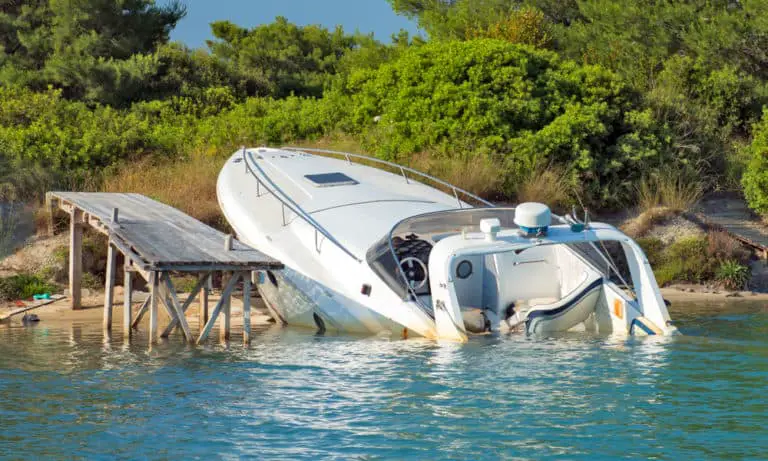
Boating Accident Statistics in 2024 (Latest U.S. Data)
Thanks to worldwide lockdowns and social distancing, we are seeing an increase in recreational boating and related accidents. Sadly, boating…
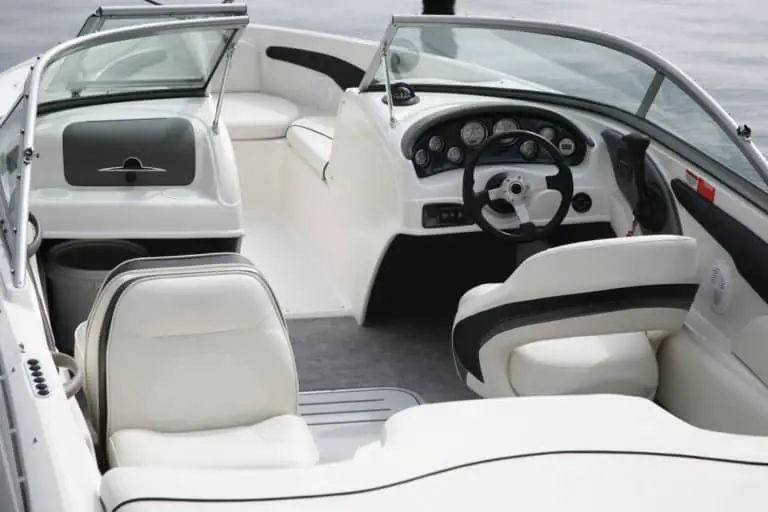
How to Clean Boat Seats? (a Practical Guide)
So you’ve bought your first boat and while you think you can master most of it with ease, you keep…
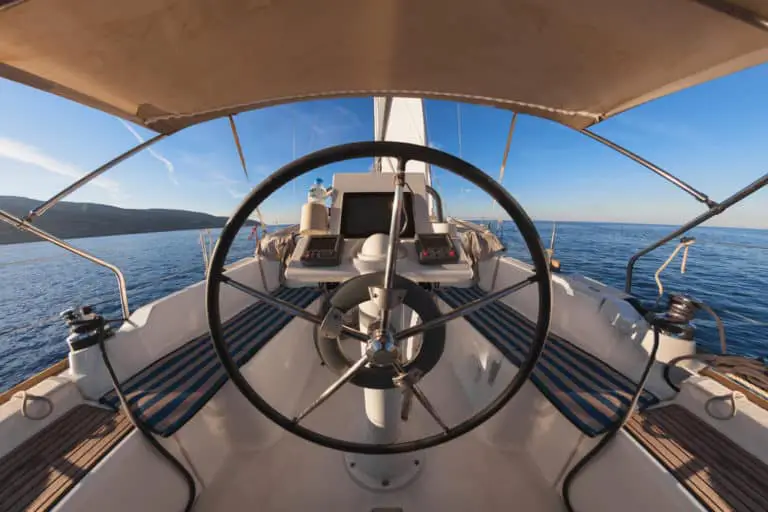
Boat Steering Systems: Everything You Need to Know (2024)
One of the most important tasks in your yearly boat maintenance routine will be the inspection and potential repair of…
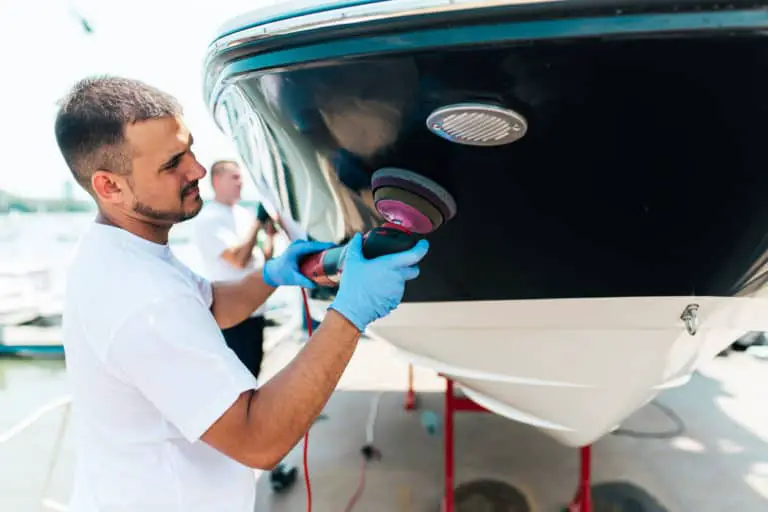
Boat Maintenance: The Definitive Guide (2024)
Many new boat owners are a little intimidated by the thought of the boat maintenance that they need to do….
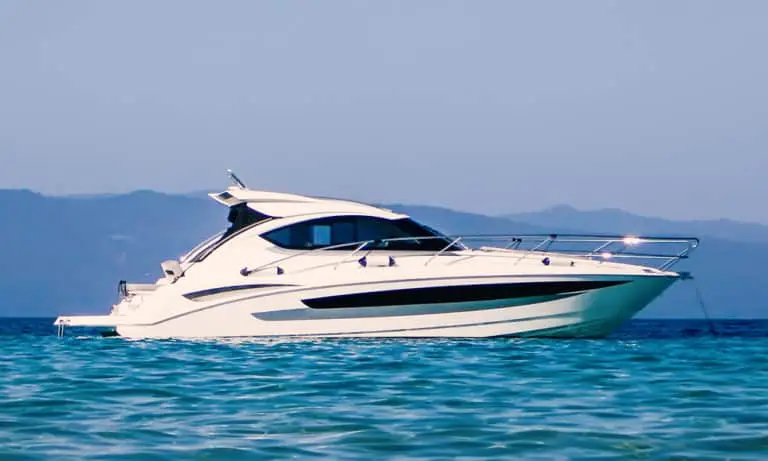
Boating Statistics in 2024 (incl. Covid & Millennials)
It’s no secret that Americans love boating as boating and fishing are the largest outdoor recreation activities in the U.S….
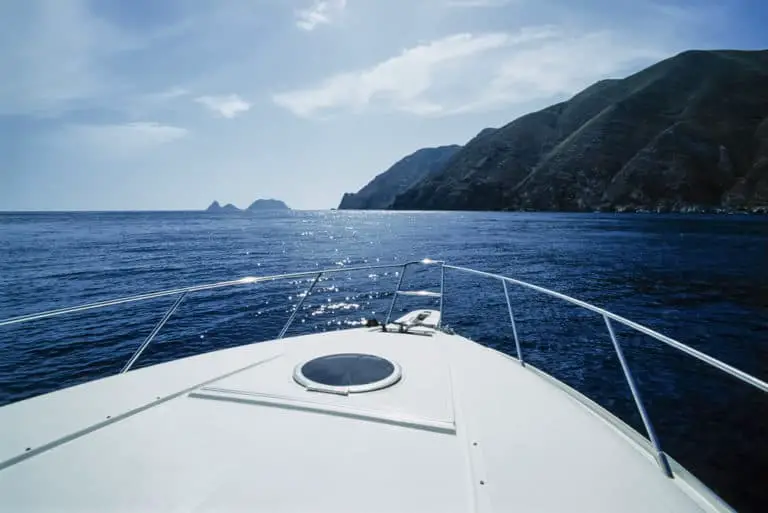
15 Practical Boating Tips for Beginners (2024)
Those new to the boating world as well as those who are simply new to owning their own boat may…
- New Sailboats
- Sailboats 21-30ft
- Sailboats 31-35ft
- Sailboats 36-40ft
- Sailboats Over 40ft
- Sailboats Under 21feet
- used_sailboats
- Apps and Computer Programs
- Communications
- Fishfinders
- Handheld Electronics
- Plotters MFDS Rradar
- Wind, Speed & Depth Instruments
- Anchoring Mooring
- Running Rigging
- Sails Canvas
- Standing Rigging
- Diesel Engines
- Off Grid Energy
- Cleaning Waxing
- DIY Projects
- Repair, Tools & Materials
- Spare Parts
- Tools & Gadgets
- Cabin Comfort
- Ventilation
- Footwear Apparel
- Foul Weather Gear
- Mailport & PS Advisor
- Inside Practical Sailor Blog
- Activate My Web Access
- Reset Password
- Pay My Bill
- Customer Service

- Free Newsletter
- Give a Gift

How to Sell Your Boat

Cal 2-46: A Venerable Lapworth Design Brought Up to Date

Rhumb Lines: Show Highlights from Annapolis

Open Transom Pros and Cons

Leaping Into Lithium

The Importance of Sea State in Weather Planning

Do-it-yourself Electrical System Survey and Inspection

Install a Standalone Sounder Without Drilling

Rethinking MOB Prevention

Top-notch Wind Indicators

The Everlasting Multihull Trampoline

In Search of the Snag-free Clew

What’s Involved in Setting Up a Lithium Battery System?

Reducing Engine Room Noise

Breaking Point: What Can Go Wrong With Your Yanmar?

Mildew-resistant Caulks for Boats

Can We Trust Plastic Boat Parts?

Repairing Molded Plastics

Mailport: Marine plywood, fuel additives, through bolt options, winch handle holders

The Day Sailor’s First-Aid Kit

Choosing and Securing Seat Cushions

Cockpit Drains on Race Boats

Rhumb Lines: Livin’ the Wharf Rat Life

Resurrecting Slippery Boat Shoes

Shoe Goo’s Gift to Sailors

Tricks and Tips to Forming Do-it-yourself Rigging Terminals

Marine Toilet Maintenance Tips

Learning to Live with Plastic Boat Bits

The Ultimate Guide to Caring for Clear Plastic
- Marine Electronics
- Personal Gear & Apparel
- Safety & Seamanship
- Sails, Rigging & Deck Gear
- Boat Maintenance
Practical Sailor Tracks Down the Best LED Tri-color Light
Testers take a look at six bulbs and lanterns from the marine led navigation light market..
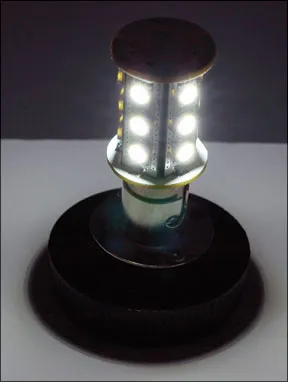
When it comes to navigation lights aboard sailboats, brighter is definitely better. And our latest tests of LED nav lights proved that more light can be made with less energy. In fact, we found that replacing a conventional incandescent bulb with a light-emitting diode (LED) of similar luminosity can result in up to a 90-percent savings in energy consumed over a given period of time.
Practical Sailor’ s previous evaluations of navigation lights (September 2005 and Jan. 15, 2002) were tests of tri-color
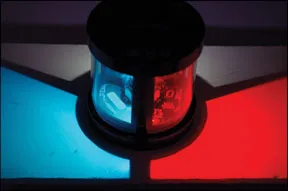
Photos by Ralph Naranjo
masthead lights, sidelights, sternlights, and all-around white lights.
For this review, we narrowed the test field and focused solely on LED tri-color navigation lights (sidelights and a stern light combined in a single fixture) because of the under-sail connotation. They are most often used when the engine is off and the alternator(s) is providing no energy boost to the battery bank. This is when miserly current consumption is most appreciated.
LED lights come in all sizes and shapes, and it has been their monumental improvement in efficiency that has made the technology so appealing to energy-constrained sailors.
In the past, the most popular means of meeting the U.S. Coast Guard’s navigation light requirements for boats under 65 feet (see “Nav Light Requirements,” below) was to use an Aqua Signal Series 40 tri-color lamp housing with its long-filament incandescent bulb. Its 25-watt energy appetite not only puts a significant load on the house battery bank, but it requires a heavier-gauge wire be run up the spar in order to avoid an energy-robbing voltage drop. Swapping out the incandescent bulb for an LED drops power consumption significantly and yields just as bright of a light. During a 10-hour night sail, this results in reducing current consumption from about 20 amp-hours down to a scan’t 2 amp-hours. This savings adds up, and the extra cost of the LED bulb or light will pay for itself in longevity and energy savings.
LED Evolution
Since the late 1960s, LEDs have followed a trend that amounts to almost a doubling of light output every 36 months. (If Wall Street had done the same, a $100 investment made in 1969 would today be worth over $500,000.)
Skipping all the esoteric physics and getting down to basics leaves us with one important concept to grasp: By passing a current through certain semiconductors (materials with only a few electron holes), the electron flow instigates photon release—or more simply put, light energy is emitted. Modern LEDs comprise an anode (+) and cathode (-) that meet in a tiny cup-like reflector that contains an “n” and a “p” layer of semiconductor material.
In order to achieve white or colored light, phosphor coatings are used. Another significant breakthrough was the prism-like lens and epoxy-sealed cavity that bundles up many of these semiconductors. The resulting “bulb” reflects and refracts the light energy produced, delivering a color-controlled beam. The plasma-like brilliance of a single-source light creates lens and reflector challenges that each light manufacturer has to deal
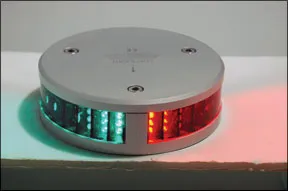
with. Some makers shape a single beam with lens elements while others use an array of multiple smaller LEDs.
What We Tested
Each of the six LED tri-color masthead lights we tested for this report took a different approach to implementing the LED technology. The test field included three LED lanterns and three LED bulbs.
From Orca Green Marine (OGM), maker of the top choice among tri-colors in the 2005 Practical Sailor test, we reviewed the latest USCG 2-nautical-mile approved tri-color. The other tested lanterns were self-contained tri-color/anchor light combos from Signal Mate and Lopolight.
Among the bulbs we tested was the Lunasea, a sealed, waterproof LED lamp comprising four green, six red, and six white LEDs. From the LED Shop in Queensland, Australia, we tested the Bay15D white LED bulb with 15 diodes. The supplier recommends its use as a low-consumption (2 watts vs. 25 watts) replacement bulb for the Aqua Signal 40 incandescent. The second sealed bulb we tested was from Dr. LED, and it is third-party certified to U.S. Coast Guard standards.
LED LANTERNS
Boat owners who don’t already have a masthead tri-color light, or who plan to replace an old one—hardware and all—would do well to consider an LED lantern.
Orca Green Marine
OGM Inc.’s USCG-approved (third-party tested) tri-color/anchor light (LXTA-12v) squeezes an amazing amount of light from a minimal amount of current (0.3 amps @ 12 volts-DC).
The well-sealed, nicely machined housing and large lenses keep the LEDs in direct line of sight, regardless of heel or the viewer’s proximity. Hard, anodized endcaps and Lexan outer lens elements form a tough, water-tight seal. Its internal
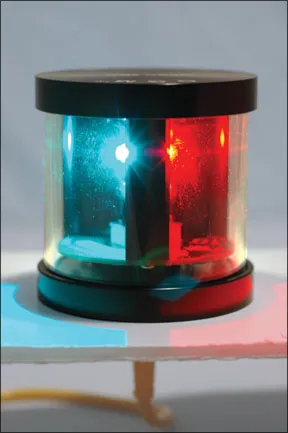
electronic components are potted in a dielectric sealant, and the lantern comes with a well-sealed pigtail connector.
The manufacturer claims a 50,000-hour full brightness LED life and offers a two-year warranty on the $340 lantern.
Testers’ main concern that arose during testing was that the OGM lantern produced the most RFI of all the gear we tested. Moving the handheld VHF radio to within 14 inches of the light obliterated radio reception.
Bottom line: The OGM lantern is the least expensive in its category, and it proved to be a well-made light. However, its RFI test results held it back.
This expensive, well-designed, and carefully manufactured LED tri-color/anchor light offers a multiple diode approach to illuminating each sector of coverage. The lamp’s geometry focuses individual LEDs in narrower beams and uses 36 to cover each colored zone and 44 in the white zone. In addition to adding redundancy with circuitry that allows individual diodes to fail without taking out the entire cluster, the design eliminated the hotspot inherent in tri-color lights that use single-point light sources for each sector.
This light offers a green that’s really green (see “Shades of Green,” page 14), a dead-ahead aspect with minimal overlap, and a crisp transition to the red zone. The Lopolight also sports a rugged, well-sealed housing that’s fully submersible.
Its current consumption is a tiny bit more than the most energy efficient in this group, but the value of having the light continue to work even if one or more diodes give up the ghost is a big plus.
At $689, the Lopolight was the most expensive product of all those we tested, but it also had the least RFI. It comes with a five-year warranty.
Bottom line: If quality construction and superior performance are your priorities—and cost isn’t a concern—the Lopolight will fit the bill. It gets the nod as Practical Sailor’s Best Choice.
Signal Mate
Signal Mate products are designed and manufactured by Maryland-based Kimberlite Assemblers Inc. The company sent us a pre-production version of its 2-nautical-mile tri-color lantern for testing.
The searing bright lantern scored high marks for energy efficiency. Its 0.3 amp draw at 12 volts DC compared to some of the more expensive lanterns.
The Signal Mate incorporates a finned alloy base that functions
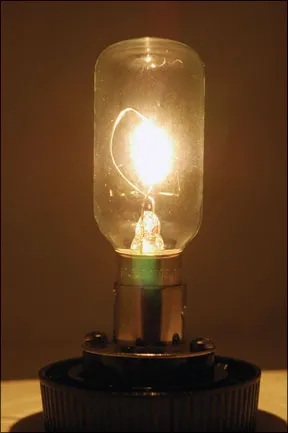
as a heat sink and houses the driver and diodes within a polycarbonate cylindrical tube. Its endcaps and electronics are sealed and bedded in Dow Tough Gel.
Its cylindrical shape makes it well suited for masthead mounting. The light output did not appear hampered at all by the unit’s comparably small lenses, even at varying angles of heel.
The design, with a single light source per sector, created a white hotspot, but from 50 to 100 yards away, it was undetectable. Hotspots, a bright white spot that occurs when a single-point white light source illuminates a colored faceted lens, are common to this design.
Just before going to press with this review, Signal Mate sent us its new production version of this lamp. Like the pre-production unit, the LED circuitry is enclosed in a polycarbonate cylinder, but it now incorporates O-ring seals and 3M 5200 adhesive to better cope with thermal expansion and contraction. Heat dissipation and RFI suppression have been improved, and the overall fit and finish have been raised a notch. The light is certified to USCG and American Boat and Yacht Council (ABYC)-16 standards.
Bottom line: The $359 Signal Mate tri-color is a cost-effective option with a good five-year warranty, and the new version boasts some necessary improvements.
The new breed of LED bulbs can add efficiency to those old Aqua Signal, Hella, and Perko incandescent nav lights that have been serving boats for decades. These plug-and-play conversions from incandescent to much more efficient LED technology are capturing market share, and the degree of this success has inspired Aqua Signal to come out with its own single-diode LED light and a new line of LED products. For those with older lamps such as the venerable Aqua Signal 40 tri-color, the following three bulb options represent good examples of what’s available in the realm of LED conversions.
The Dr. LED Polar Star 40 replacement bulb for the Aqua Signal 40 lantern comes with an interesting note. According to the Seattle firm, “a white LED should not be used behind colored lenses.” And to that end, its LED replacement bulb has three distinct color-enhanced sectors indigenous to the bulb itself. These are not stand-alone red, green, and white sectors, but instead are color-enhancing segments that ensure that red is red and green is a bright and deep shade of green. This reduced the bulb’s hotspot.
The bulb is designed in the U.S., made in China, and meets the 2-nautical-mile visibility, chromaticity, and other demands of the ABYC/USCG standards. It was the lowest current-consuming light in our test (0.1 amps), and though not the
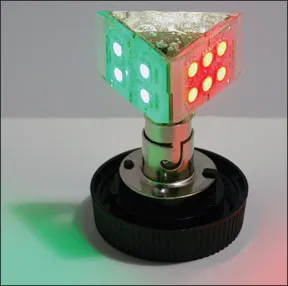
brightest, it was visible and color recognizable at the 2-mile range.
Bottom line: Middle of the pack price-wise, this $50 current miser gets a Practical Sailor Budget Buy among LED bulbs for conversions.
Lunasea Lights
This well-sealed, wedge shaped, waterproof bulb uses separate LEDs for each color zone. The red sector held six LEDs, and the green four. Light-meter readings indicated that the red sector was a bit brighter than the green sector during tests. At distances beyond 100 yards, the discrepancy was not noticeable visually. Both segments could be seen at the 2-nautical-mile range.
This bulb seemed to only need a clear housing because of the excellent chromaticity match, but without being placed in a tri-lens housing, it had a rather large overlap of red and green. We noted that the red and green (bow-on aspect) covered an arc of more than 20 degrees. But by placing the tri-color lens over the bulb, the overlap was brought into an acceptable 10-degree range, creating a bright, very distinguishable tri-color light.
The Lunasea bulb was the only one in its group with the ability to keep shining even if one of the multiple diodes failed.
Bottom line: One of the brightest LEDs tested, the Lunasea light gets the Practical Sailor Recommended pick among bulbs for its top performance and lifetime warranty, the only test product to offer one.
Distributed by the Australia-based LED Shop, the white BAY-15D bulb we tested was a cluster of 15 diodes in pentagonal array of three vertical diodes per segment. This bright-white light makes a superb anchor light, and the LED Shop also recommends it as a replacement bulb for the Aqua Signal Series 40 tri-color light.
In our testing, it provided a bright red and green sector, but its colors were not as saturated as the color-specific bulbs by Dr. LED and Lunasea.
Testers’ biggest concern was the fact the bulb isn’t properly sealed. This does afford better heat dissipation, a key factor in LED longevity, but we prefer sealed bulbs.
However, the BAY-15D’s $27 price tag, its brightness and

minimal RFI make it a bargain as an anchor light bulb.
Bottom line: Although inexpensive and a good performer, the BAY-15D was held back by its lack of a good seal.
- Nav Light Requirements
- How We Tested
- Practical Sailor Value Guide: Led Tri-Color Masthead Lights
- Shades of Green
- View PDF Format
RELATED ARTICLES MORE FROM AUTHOR
Which version of the OGM was tested for this review?
It would be helpful if you added the part numbers of the specific product that you’re testing. For example, when I went to the Lopolight website, I couldn’t find the product you tested. I’m a little disappointed that you didn’t test any trilights with the strobe or flash function. Perhaps I’ll keep my 20-year old Hella.
LEAVE A REPLY Cancel reply
Log in to leave a comment
Latest Videos
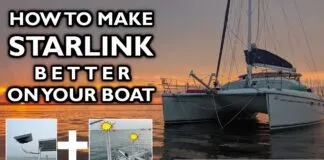
How To Make Starlink Better On Your Boat | Interview

Catalina 380: What You Should Know | Boat Review
- Privacy Policy
- Do Not Sell My Personal Information
- Online Account Activation
- Privacy Manager

- CLASSIFIEDS
- NEWSLETTERS
- SUBMIT NEWS
The Best Lopolight Navigation Lights for Sailboats from 12 to 20 Meters
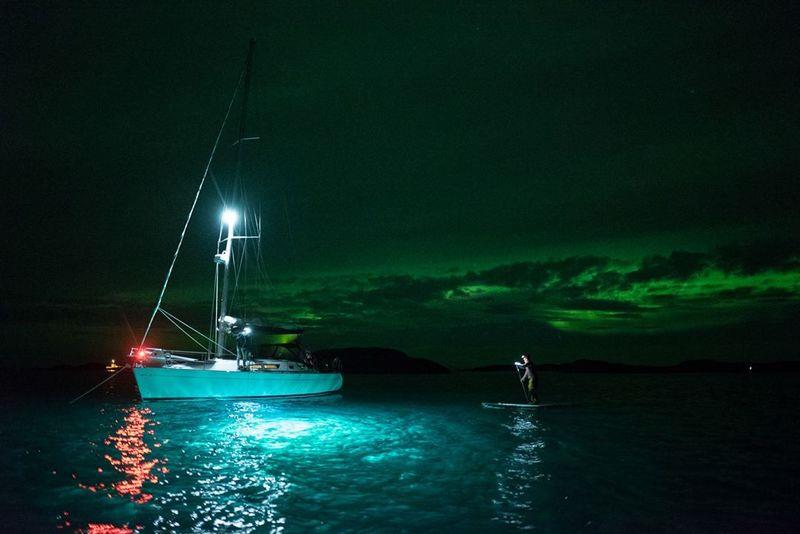
Related Articles
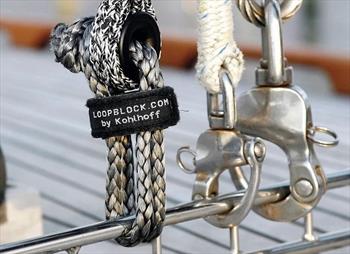

Service Locator
- Angler Endorsement
- Boat Towing Coverage
- Mechanical Breakdown
- Insurance Requirements in Mexico
- Agreed Hull Value
- Actual Cash Value
- Liability Only
- Insurance Payment Options
- Claims Information
- Towing Service Agreement
- Membership Plans
- Boat Show Tickets
- BoatUS Boats For Sale
- Membership Payment Options
- Consumer Affairs
- Boat Documentation Requirements
- Installation Instructions
- Shipping & Handling Information
- Contact Boat Lettering
- End User Agreement
- Frequently Asked Questions
- Vessel Documentation
- BoatUS Foundation
- Government Affairs
- Powercruisers
- Buying & Selling Advice
- Maintenance
- Tow Vehicles
- Make & Create
- Makeovers & Refitting
- Accessories
- Electronics
- Skills, Tips, Tools
- Spring Preparation
- Winterization
- Boaters’ Rights
- Environment & Clean Water
- Boat Safety
- Navigational Hazards
- Personal Safety
- Batteries & Onboard Power
- Motors, Engines, Propulsion
- Best Day on the Water
- Books & Movies
- Communication & Etiquette
- Contests & Sweepstakes
- Colleges & Tech Schools
- Food, Drink, Entertainment
- New To Boating
- Travel & Destinations
- Watersports
- Anchors & Anchoring
- Boat Handling
- ← Safety & Prevention
Navigation Light Standards
Advertisement
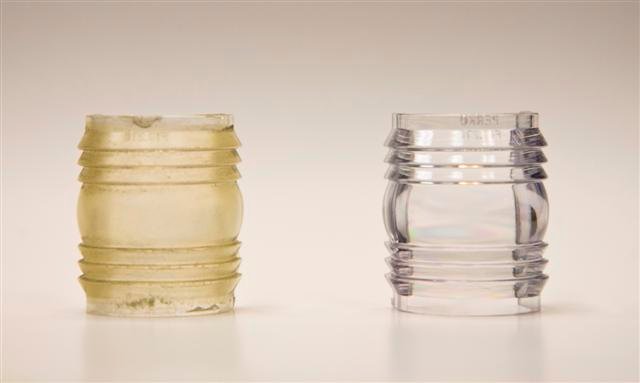
Old degraded lenses may interfere with light emission to the extent that you are no longer in compliance with the Rules.
U.S. navigation light standards conform closely to the international COLREGS (collision regulations). Called the Inland Navigation Rules or Unified Rules, the U.S. regulations require all boats built after December 24, 1981, to be in compliance. No retrofit is necessary on boats built before this date if they are in compliance with previous inland rules. However, in international waters, these boats would not be in compliance with the COLREGS and could be deemed liable in an accident.
Visibility of Navigation Lights
Vessels under 39.4' (12 meters).
- White/Red/Green or Yellow 360° - 2 n.m.
- Masthead - 2 n.m.
- Stern - 2 n.m.
- Red/Green - 1 n.m.
- Towing - 2 n.m.
Vessels 39.4-65.6' (12-20 Meters)
- Masthead - 3 n.m.
- Red/Green - 2 n.m.
Placement of Navigation Lights
Boats under 23' may carry a 360° lantern or flashlight in lieu of running lights. Also, international regulations allow sailboats under 65.6' (20 meters) to display a single masthead tricolor navigation light while under sail. All-around lights must be a minimum of 1 meter (39 3/8") above the red/green sidelights on boats under 12 meters (39.4 ft).
The Rules of the Road should be followed and any comment herein that is inconsistent with said Rules should be disregarded and the Rules followed.
For the Rules see the U.S. Coast Guard Navigation Center.
Related Articles
The truth about ceramic coatings for boats.
Our editor investigates the marketing claims of consumer-grade ceramic coatings.
Fine-Tune Your Side Scan Fishfinder
Take your side-scanning fishfinder off auto mode, and you’ll be spotting your prey from afar in no time
DIY Boat Foam Decking
Closed-cell foam flooring helps make boating more comfortable. Here’s how to install it on your vessel
Click to explore related articles
BoatUS Editors
Contributor, BoatUS Magazine
Award-winning BoatUS Magazine is the official publication of Boat Owners Association of The United States. The magazine provides boating skills, DIY maintenance, safety, news and more from top experts.
BoatUS Magazine Is A Benefit Of BoatUS Membership
Membership Benefits Include:
Subscription to the print version of BoatUS Magazine
4% back on purchases from West Marine stores or online at WestMarine.com
Discounts on fuel, transient slips, repairs and more at over 1,200 businesses
Deals on cruises, charters, car rentals, hotel stays and more…
All for only $25/year!
We use cookies to enhance your visit to our website and to improve your experience. By continuing to use our website, you’re agreeing to our cookie policy.
Get your card today

- Pre-paid code

- Buy a Gift Card
Navigation Lights for Sailboats and Human-Powered Vessels
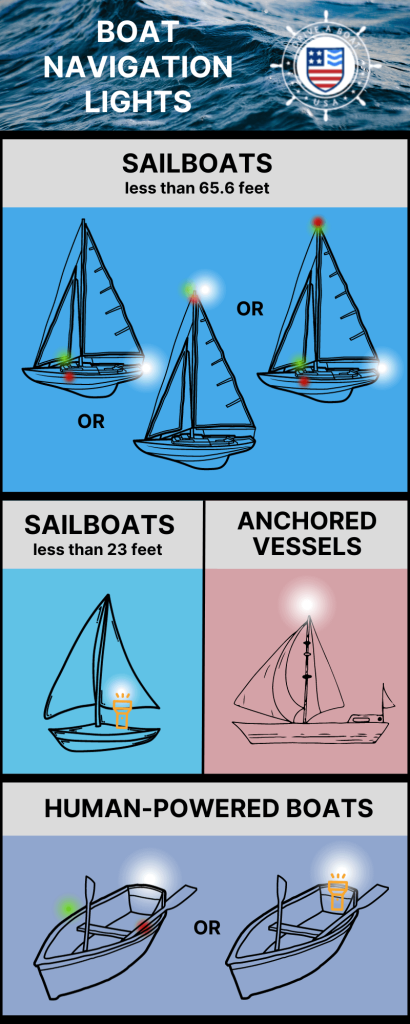
Navigation lights are an important element of boating safety equipment for all boats, including sailboats and human-powered vessels. If you are operating a sailboat or nonpowered boat such as a canoe, kayak or rowboat, you need to know when to use navigation lights. You also need to be aware of the correct configuration of navigation lights for your boat size and boating circumstances.
Sailboat definition
A sailboat is any boat with sails as its principle mode of propulsion. Types and models of sailboat include, among others:
Human-powered watercraft definition
A human-powered watercraft is a boat that is propelled by human power through the use of hand and feet, oars, paddles, poles or pedals, but not sails or an engine. Examples of human-powered watercraft:
- Paddleboards
- Watercycles
- Rowing shells
Boat navigation lights: general
You are legally responsible for displaying the right type of navigation lights when your boat is away from the dock. There are several things to consider when figuring out which lights you need to have on board:
- The length of your boat
- The speed of your boat
- Where you are boating (inland, international waters, etc.)
- Whether you are at anchor.
Remember that your navigation lights must be visible and easily identifiable at all times. Other lights on your boat should be easily differentiated from your navigation lights, and should never block your navigation lights.
Human-powered vessels with engines
Some human-powered vessels or sailboats, such as motorsailors, may also have an engine on board. As soon as that engine is in use, your boat immediately becomes bound by the laws governing navigation lights for powered boats.
Navigation lights for human-powered vessels and sailboats
For comprehensive detailed instructions on navigation lights it is advisable to refer to the laws outlined by the United States Coast Guard. In general, sailboats and human-powered vessels require the following basic navigation lights:
Sailboats or vessels using paddles or oars, under 23 feet in length:
- One white navigation light (or lantern or flashlight) that is visible from 2 nautical miles away between sunset and sunrise or during periods of low visibility. In the presence of other vessels, this light must be displayed in time to avoid a collision.
Sailboats between 23 and 65.6 feet:
- One white stern light visible at 135 degrees and from 2 nautical miles away.
- One green starboard and one red port sidelight, visible across 112.5 degrees from one nautical mile away.
- A tricolour light, which is a single all-around light which includes the three coloured of lights indicated above, facing the same directions, visible from a distance of 2 miles. This type of light can only be used when under sail, and never when using a motor regardless of whether the sails are hoisted. It may not be used at the same time as regular sidelights.
Navigation lights for nonpowered boats at anchor
When your boat is anchored at a dock, you do not need to use your navigation lights. However, if you are at anchor away from the dock, you need to inform other boats that you are not moving. To do this, you can display an all-around white light somewhere on your boat where it will be easily visible to any other boats in the area.
Interpreting navigation lights
Installing and using the right navigation lights on your boat is essential, but you also need to be able to interpret the navigation lights on other boats.
Remember, the boat captain remains fully responsible for doing everything possible to avoid collisions at all times, and for using all safety equipment correctly, from navigation lights to boat fire extinguishers and inflatable PFDs .
Learn about boat navigation lights with Drive a Boat USA
You can trust Drive a Boat USA to teach you how to take to the water in complete safety, including the correct use of boat navigation lights, through our premium boating safety course . Sign up today to earn your very own official state-approved boating license!
- USA Boating
Latest Posts
- Guide to Towing and Trailering a Boat
- Complete Boat Safety Equipment Checklist
- How to Launch a Boat: Complete Guide
- Complete Boat Maintenance Checklist
- What Should Be Included on a Float Plan?
- February 2024
- December 2023
- October 2023
- September 2023
- January 2023
- November 2022
- Get certified now
- Replacement California Boater Card
Chapter 2: Boating Safety
Navigation light requirements.
Navigation lights are generally mandatory during times of limited visibility regardless of the type of vessel. These lights are invaluable because they allow boaters to identify the type of vessels around them, as well as their relative size. While learning the different arrangements which apply to different vessels, pay close attention to the differences between the navigation light requirements for unpowered and powered vessels.
Navigation Lights for Unpowered Vessels:
If a sailboat is over 23 feet (7 meters), the following standards must be met:
Unpowered boats of this size also have the option of using an all-around light set up, which is also referred to as a tricolor light.
Vessels over 23 feet (7 meters) but under 65.62 feet (20 meters) also have the option of using a combined red over green configuration mast light.
If a sailboat is under 23 feet (7 meters), the following standards must be met:
Navigation Lights for Powered Vessels:
If a powerboat is Greater than 39.4 feet (12 meters), but less than 65.6 feet (20 meters), the following standards must be met:
Additionally, the masthead must be placed at least 8 feet above the gunnel. Refer to Figure D as an example of the proper configuration. These rules also apply to sailboats using a motor.
If a powerboat is less than 39.4 feet (12 meters), the following standards must be met:
Similarly, powered vessels under 7 meters, with speeds under 7 knots, may feature a white all-around light that is visible from two miles away and, if possible, a pair of red and green sidelights in international waters only.
Additionally, the all-around white light must be positioned at least 39 inches above the sidelights. Refer to Figure A as an example of the proper configuration. Note that sailboat in Figure E is using a motor. Even if a sailboat is flying its sail it may still be under engine power, in which case, it is treated as a powered vessel. Therefore, it is vital to note the configuration of a vessel's navigation lights, and what they communicate about the vessel.
If a vessel is at anchor, the following standards must be met:
This covers the sizes of boats typically operated as a recreational boat. For larger vessels, refer to the U.S. Coast Guard Navigational Rules and Regulations Handbook.
Course Signup: Location
Privacy Policy
This privacy policy is intended to provide information to users of Boater's Academy's websites, and users of the services provided by Boater's Academy, about how Boater's Academy uses, stores, and protects information associated with such users. By using any of the websites or services of Boater's Academy, you represent and warrant that you have read and understood this privacy policy, and agree to its terms.
Effective Date Of Policy
The effective date of this privacy policy is 01/01/2018. Boater's Academy reserves the right, at any time and without notice, to add to, update, change, or modify this privacy policy by posting a new version on this page.
Information Collected By Boater's Academy
When you access Boater's Academy websites, Boater's Academy automatically gathers information that most web browsers automatically make available. This information may include IP addresses, Internet domain names, and types of devices and web browsers accessing Boater's Academy websites. Such information is anonymous and is not meant to personally identify you.
Boater's Academy websites also use cookies, which are files that are placed on your computer when you visit Boater's Academy websites. The purpose of cookies includes identifying you as a unique user of Boater's Academy websites and services, tailoring your experience on Boater's Academy websites, and enabling third-parties (such as Google) to optimize and serve advertisements to you.
If you do not wish to have cookies placed on your computer, you have several options, including: (a) not accessing Boater's Academy websites or using Boater's Academy services; (b) setting your web browser to refuse cookies; and (c) opting out of or customizing the use of third-party cookies through various websites operated by such third parties or by others (i.e., Google, Facebook, and Network Advertising Initiative). Please note that blocking or customizing the use of cookies may affect your experience on Boater's Academy websites or with Boater's Academy services.
If you decide to use certain features of Boater's Academy websites or services (such as ordering a product or service), you will be asked to provide certain personally identifiable information, which can include your name, phone number, email address, mailing address, credit/debit card number and expiration date, and social security number. You are under no obligation to provide such information, but refusing to do so may prevent your ability to use certain features of Boater's Academy websites or services.
How Boater's Academy Uses The Information It Collects
With respect to non-personally identifiable information automatically collected from you when you access Boater's Academy websites and information gathered through the use of cookies, Boater's Academy uses such information to: (1) help diagnose problems with our server and administer our websites; (2) track the usage of our websites so we can better understand who is using our websites and services and how they are using them; and (3) share with advertisers to help them better understand our services and the preferences of our customers.
Boater's Academy may combine certain demographic information obtained from you when you use certain features of Boater's Academy websites or services (such as registering or ordering a product or service) with site usage data to provide profiles, in aggregate form, about our users and their preferences. The aggregate, composite information may be shared with our advertisers.
The personally identifiable information you voluntarily provide to Boater's Academy when you decide to use certain features of Boater's Academy websites or services (such as registering or ordering a product or service) may be used for the following purposes: (1) contacting you regarding Boater's Academy's products or services, including those which you have ordered or requested; (2) billing you for the products or services your ordered or requested; (3) providing the information to third parties such as shipping companies, merchant account and payment gateway service providers, governmental entities, and our product and service distributors to the extent necessary to provide the products and services that you order or request; (4) providing the information to those who assist Boater's Academy with providing its products and services; (5) providing the information when required to do so by law or if necessary to protect the property or rights of Boater's Academy, third parties, or the public; (6) providing the information to a successor of Boater's Academy in the event of a merger, acquisition, bankruptcy, or sale of Boater's Academy's assets; and (7) providing the information to consumer credit reporting services, collection agencies, attorneys, and others in the event you fail to pay any amounts owed to Boater's Academy.
In disclosing your personally identifiable information, Boater's Academy will disclose only so much of the information as is necessary to provide the products and services that you request or order.
Security Of Information Provided To Boater's Academy
Boater's Academy takes security seriously and uses commercially reasonable safeguards to protect against the unauthorized access, use, modification, destruction or disclosure of any information you provide to us. However, Boater's Academy cannot guarantee that any information provided to us or obtained by us will not be accessed, hacked, disclosed, altered, or destroyed by unauthorized parties.
Children's Privacy
Boater's Academy does not solicit or knowingly collect personal information from children under the age of 13. If Boater's Academy obtains actual knowledge that it has collected personal information from a child under the age of 13, we will delete such information from our database. Because Boater's Academy does not collect personal information from children under the age of 13, we have no such information to use or disclose to third parties.
Parents of minors of any age may contact our Privacy Coordinator at the mailing address or e-mail address indicated below in order to: (1) access personally identifiable information Boater's Academy has collected from their child; (2) correct or modify such information; (3) request to have such information deleted; and (4) request that we no longer collect or maintain such information.
How To Request Changes To The Personally Identifiable Information We Collect
You can review and request changes to the personally identifiable information that Boater's Academy has collected from you by contacting our Privacy Coordinator at the mailing address or e-mail address indicated below.
Do-Not-Track Disclosure
Boater's Academy does not respond to "Do Not Track" signals sent by browsers.
Consent To Receive Communications
By providing your name, email, mailing address, and/or phone number to Boater's Academy, you consent to receive electronic and other communications from Boater's Academy. You may opt out of receiving electronic communications at any time by: (a) following the unsubscribe instructions contained in each communication; or (b) by contacting our Privacy Coordinator at the mailing address or e-mail address indicated below.
Third-Party Websites
Boater's Academy is not responsible for the content of websites operated by third parties to which it may provide links on Boater's Academy's websites or for the websites of advertisers. Such third parties and advertisers may also have privacy policies that are different from this privacy policy. Therefore, you should inform yourself of the privacy policies and practices of any websites of third parties or advertisers.
Contacting Us
If you have any questions about this privacy policy, Boater's Academy websites, or Boater's Academy products and services, please contact our Privacy Coordinator at the mailing address or e-mail address indicated below:
Boater's Academy Attn: Privacy Coordinator P.O. Box 5143 Virginia Beach, VA 23471 [email protected]
Terms of Use
Introduction
Welcome to Boater's Academy. This website is owned and operated by enLearned LLC. By visiting our website and accessing the information, resources, services, products, and tools we provide, you understand and agree to accept and adhere to the following terms and conditions as stated in this policy (the "User Agreement").
This User Agreement is in effect as of 01/01/2018.
We reserve the right to change this User Agreement from time to time without notice. You acknowledge and agree that it is your responsibility to review this User Agreement periodically to familiarize yourself with any modifications. Your continued use of this site after such modifications will constitute acknowledgment and agreement of the modified terms and conditions.
Responsible Use and Conduct
By visiting our website and accessing the information, resources, services, products, and tools we provide for you, either directly or indirectly (the "Resources"), you agree to use the Resources only for the purposes intended as permitted by (a) the terms of this User Agreement; and (b) applicable laws, regulations and generally accepted online practices and guidelines.
You agree that:
a. In order to access our Resources, you may be required to provide certain information about yourself (such as identification, contact details, payment information, and other information) as part of the registration process, or as part of your ability to use the Resources. You agree that any information you provide will be accurate, correct, and up to date.
b. You are responsible for maintaining the confidentiality of any login information associated with any account you use to access our Resources. Accordingly, you are responsible for all activities that occur under your account(s).
c. Accessing (or attempting to access) any of our Resources by any means other than through the means we provide, is strictly prohibited. You specifically agree not to access (or attempt to access) any of our Resources through any illegal, automated, unethical or unconventional means.
d. Engaging in any activity that disrupts or interferes with our Resources, including the servers and/or networks to which our Resources are located or connected, is strictly prohibited.
e. Attempting to copy, duplicate, reproduce, sell, trade, or resell our Resources is strictly prohibited.
f. You are solely responsible any consequences, losses, or damages that we may directly or indirectly incur or suffer due to any unauthorized activities conducted by you and you may incur criminal or civil liability for such unauthorized activities.
g. We may provide various open communication tools on our website, including but not limited to blog comments, blog posts, public chat, forums, message boards, newsgroups, product ratings and reviews, and various social media services. We do not always pre-screen or monitor the content posted by users of these various communication tools, which means that if you choose to use these tools to submit any type of content to our website, then it is your personal responsibility to use these tools in a legal, responsible and ethical manner. By posting information or otherwise using any open communication tools as mentioned, you agree that you will not upload, post, share, or otherwise distribute any content that:
i. Is illegal, threatening, defamatory, abusive, harassing, degrading, intimidating, fraudulent, deceptive, invasive, racist, or contains any type of suggestive, inappropriate, or explicit language;
ii. Infringes on any trademark, patent, trade secret, copyright, or other proprietary right of any person or entity;
iii. Contains any type of unauthorized or unsolicited advertising;
iv. Impersonates any person or entity, including any Boater's Academy employees or representatives.
We have the right at our sole discretion to remove any content that, we feel in our judgment does not comply with this User Agreement, along with any content that we feel is otherwise offensive, harmful, objectionable, inaccurate, or violates any copyrights or trademarks. We are not responsible for any delay or failure in removing such content. If you post content that we choose to remove, you hereby consent to such removal, and waive any claim against us for such removal.
h. We do not assume any liability for any content posted by you or any other third party users of our website. However, any content posted by you using any open communication tools on our website, provided that it doesn't violate or infringe on any third party copyrights or trademarks, becomes the property of enLearned LLC, and as such, gives us a perpetual, irrevocable, worldwide, royalty-free, exclusive license to reproduce, modify, adapt, translate, publish, publicly display and/or distribute as we see fit. The foregoing only applies to content posted via open communication tools, and does not apply to information that is provided as part of the registration process as part of your use of the Resources.
i. You agree to indemnify and hold harmless enLearned LLC, Boater's Academy, their parent company/companies and affiliates, and their directors, officers, managers, employees, agents, successors, assigns, and licensors (collectively, the "enLearned LLC Parties"), from and against all losses, expenses, damages and costs, including reasonable attorneys' fees, resulting from any violation of this User Agreement or the failure to fulfill any obligations relating to your account incurred by you or any other person using your account. We reserve the right to take over the exclusive defense of any claim for which we are entitled to indemnification under this User Agreement. In such event, you shall provide us with such cooperation as is reasonably requested by us.
Limitation of Warranties
The enLearned LLC Parties expressly disclaim any and all warranties, express or implied, regarding the Resources, arising by operation of law or otherwise, including without limitation any and all implied warranties of merchantability, quality, accuracy, fitness for a particular purpose, non-infringement, no encumbrance, or title, in addition to any warranties arising from a course of dealing, usage, or trade practice.
The Resources are provided with all faults, and the entire risk as to satisfactory quality, performance, accuracy, and effort is with the user.
The enLearned LLC Parties do not warrant that the Resources will fulfill any of your particular purposes or needs, or that the operation or use of the Resources will be uninterrupted or error-free. The enLearned LLC Parties disclaim all implied liability for damages arising out of the furnishing of the Resources pursuant to this User Agreement, including without limitation, mistakes, omissions, interruptions, delays, tortious conduct, errors, representations, or other defects arising out of the failure to the furnish the Resources, whether caused by acts of commission or omission, or any other damage occurring.
Limitation of Liability
In conjunction with the Limitation of Warranties as explained above, you expressly understand and agree that your potential recovery for any claim against the enLearned LLC Parties arising from or relating to the Resources or this User Agreement shall be limited to the amount you paid, if any, for use of products and/or services. The enLearned LLC Parties will not be liable for any direct, indirect, incidental, consequential or exemplary loss or damages which may be incurred by you as a result of using the Resources, or as a result of any changes, data loss or corruption, cancellation, loss of access, or downtime.
Copyrights, Trademarks, and License
Subject to your compliance with this User Agreement, the enLearned LLC Parties grant you a non-exclusive, non-sublicensable, revocable as stated in this User Agreement, non-transferable license to access the Boater's Academy websites, and to use the Resources. The Resources, including any portion of Boater's Academy websites, may not be reproduced, duplicated, copied, modified, sold, resold, distributed, transmitted, or otherwise exploited for any commercial purpose without the prior, express written consent of the enLearned LLC Parties. All rights not expressly granted in this User Agreement are reserved by the enLearned LLC Parties. Without limitation, this User Agreement grants you no rights to the intellectual property of the enLearned LLC Parties or any other party, except as expressly stated in this User Agreement. The license granted in this section is conditioned on your compliance with this User Agreement. Your rights under this section will immediately terminate if you breach, actually or potentially, in the sole judgment of the enLearned LLC Parties, any provision of this User Agreement.
Termination of Use
You agree that we may, at our sole discretion, suspend or terminate your access to all or part of our website and Resources with or without notice and for any reason, including, without limitation, breach of this User Agreement. Any suspected illegal, fraudulent or abusive activity may be grounds for terminating your relationship with Boater's Academy and may be referred to appropriate law enforcement authorities. Upon suspension or termination, your right to use the Resources we provide will immediately cease, and we reserve the right to remove or delete any information that you may have on file with us, including any account or login information.
By using or accessing Boater's Academy websites and the Resources, you represent and warrant that you have read and understood the Privacy Policy, which is incorporated by reference into this User Agreement, and agree to be bound by its terms. The Privacy Policy is available at http://boatersacademy.com/index#privacy .
Dispute Resolution, Governing Law, Attorneys' Fees
This User Agreement shall be governed and construed in accordance with the laws of the Commonwealth of Virginia without regard to its conflict of law principles.
Any and all claims, actions, demands, causes of action, and other proceedings ("Claim" or "Claims") involving you and any of the enLearned LLC Parties arising from or relating to the Resources or this User Agreement shall be heard in a court or courts of competent jurisdiction in Virginia Beach, Virginia. You hereby agree to personal jurisdiction by such courts, and waive any jurisdictional, venue, or inconvenient forum objections to such courts.
You agree that any Claim you bring against any of the enLearned LLC Parties will only be in your individual capacity and not as a plaintiff or class member in any purported class or representative proceeding.
If any of the enLearned LLC Parties initiates a Claim against you arising from or relating to the Resources or this User Agreement, the enLearned LLC Parties will be entitled to recover from you their reasonable costs and attorneys' fees incurred as a result of such Claim. If you initiate a Claim against any of the enLearned LLC Parties arising from or relating to the Resources or this User Agreement, and any of the enLearned LLC Parties prevail on such Claim, the enLearned LLC Parties will be entitled to recover from you their reasonable costs and attorneys' fees incurred as a result of such Claim.
REFUND POLICY
Refunds will only be issued in the event that you are unable to access the Resources through no fault of your own (i.e., due to an outage or other non-functionality of Boater's Academy websites) for a period forty-eight (48) hours commencing with the time that you register and pay for access to the Resources. No refunds will be issued once you receive a Certificate of Completion.
CONTACT INFORMATION
If you have any questions or comments about this User Agreement, you can contact us at:
Boater's Academy P.O. Box 5143 Virginia Beach, VA 23471 [email protected]
JavaScript seems to be disabled in your browser. For the best experience on our site, be sure to turn on Javascript in your browser.

- Create an Account
- Marine Boat Lights
Boat Navigation Lights

Boat Navigation Lights How-Tos
Infographic: boat navigation lighting requirements.
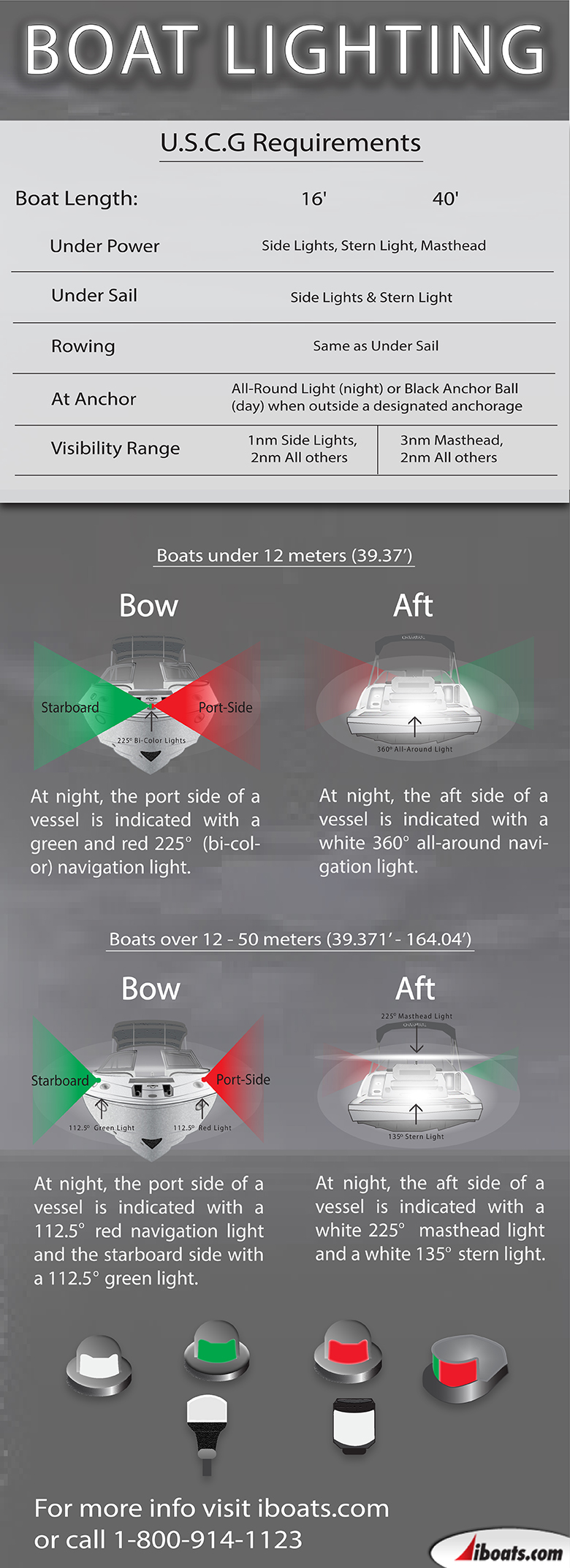
- Nav Light Mounts & Bases 27 items
- Boat Bow-Lights & Combo Side-Lights 65 items
- All-Round Anchor Pole Lights 230 items
- Boat Side Lights 100 items
- Boat Masthead Lights 55 items
- Boat Pole Light Bases 15 items
- Boat Transom Stern Lights 80 items
- Portable Navigation Lights 22 items

Best LED Navigation Lights

Last Updated by
Daniel Wade
May 3, 2023
Key Takeaways
- Navigation lights offer safety to you and other boaters
- You must understand how boat navigation lights rules are important
- Bow light and stern light are red and green respectively
- Pontoon boat navigation lights are similar to other marine navigation lights and their use
- The best boat navigation lights will vary based on a variety of factors to you
Boating at night requires proper lighting in order to ensure safe travels. So what are some of the best LED navigation lights?
Brands such as Shangyuan, Linkstyle, Partsam, and Obcursco make high quality LED boat navigation lights. Each brand will have a variety of factors that make them the best LED boat navigation lights such as price, quality of materials, and a super bright light.
In my years of experience some brands are definitely better than others. Price appears to be a driving factor but keep in mind what the boat lights intended use is for and how it applies to your situation.
Table of contents
The Top 12 Best LED Boat Navigation Lights
Using LED boat lights is a smart choice for those who frequently sail or engage in open water activities. These are especially needed to obtain sufficient lighting for both the interior and exterior of their boat during night or dawn trips.
Partsam LED Lights

The Partsam round chrome light is a waterproof LED boat navigation light that doubles as an interior boat cabin light. It is made from top chrome bezel and high-grade plastic that make it durable and lightweight.
It comes with mounting screws and is easy to install with its flush mount. It is also compatible with 12 volt DC power.
- Waterproof and durable against all elements
- Can be used in both interior or exterior of your boat
- Installation is easy and it is super bright
- Not meant to be submerged especially in salt water
- Cannot dim the lights
Shangyuan Boat Navigation Lights LED Strip

The Shangyuan LED boat running lights are versatile and reliable for use all over the boat. These are especially used for:
- Stern lights
- Starboard and port sides
These LED boat navigation lights are ideal for small boats, kayaks, pontoons, and sailboats. The 3.8-inch LED strips are green for the starboard side and red for the port side. They meet maritime requirements and are battery-powered.
These running lights can withstand harsh marine conditions and provide exceptional brightness and performance. The slim ABS casing needs careful screw tightening to avoid cracking. They are easy to install and durable even in harsh environments during hunting and winter seasons.
- Be seen on the water with proper navigation lights
- Energy efficient
- Overtightening the screw can damage light casing
- Meant for small boats
Obcursco LED Navigation Lights Kit
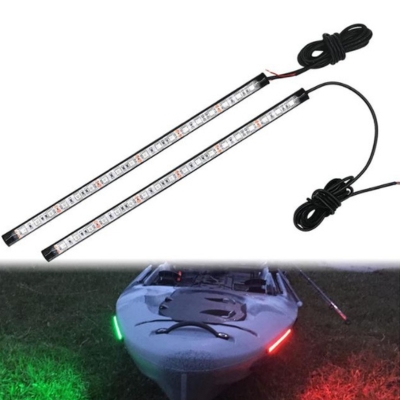
Obcursco makes a great boat navigation light kit. This LED navigation light is perfect for low light settings and rough weather with a 12v DC power and IP67 waterproof rating.
It is corrosion-resistant and impact-proof thanks to the ABS material while tightly sealed LEDs ensure full waterproofing. With easy installation using 3M adhesive it is a versatile option for boats and land use alike.
- Easy to adjust lights
- Waterproof and has durable materials
- Easy to install
- Might need to glue the lights in addition to the 3M tape
- Does not include instructions
Linkstyle Marine Boat Navigation Lights

Linkstyle's marine LED boat navigation lights are a durable and versatile option for various boat types. Its corrosion-resistant design features waterproof red and green LED units, an ABS plastic casing with a stainless steel enclosure, and polycarbonate-lenses lamps.
The lightweight and easy-to-install design is ideal for hunting and fishing. The 225-degree mounting angle ensures maximum luminance and safety compliance. These IP65 waterproof safety lamps use 16 LED bulbs powered by a 12V battery to widen visibility during reduced visibility conditions.
- Lightweight and durable to outdoor marine conditions
- Easy installation
- Ideal for smaller boats
- Installing wrong may cause navigation issues
- Not meant for larger boats
OPT7 Aura PRO LED Kit

The OPT7 Marine LED Kit is for hassle-free and waterproof boat lighting. It features SoundSync bass-activated technology, a handheld remote, and one-touch color selection with advanced dimming options.
The kit contains four LED strips, connectors, extension wires, power harness, mounting kit, and other accessories. This beats looking for everything individually but the price point might deter some buyers wanting a simple setup.
- Super bright lighting
- Easy to install and plug into 12 volt power
- Comes with remote and various light features
- Remote is not the best quality
- Might be overpriced for those wanting a simpler LED kit
Interwebz Boat Bow Navigation

Interwebz has waterproof LED bow navigation lights in red and green for boats that can be connected to a 12-volt battery or a standard pole. Proper labeling is required for night trips.
It has stylish mounting options for the boat's rub rail with a black cover that blends in with the exterior surfaces. Suitable for various boats such as bass, ski, and fishing boats, the lights are weatherproof with an IP68 rated silicone casing.
- Easily seen lighting
- Has six foot cord to connect anywhere on the boat
- Great weatherproof rating
- Likely have to use marine grade silicone to keep it secure
PryEU Daylight White

The PryEU Daylight White 6000K is an energy-efficient and versatile waterproof lighting fixture that uses 3M double-sided foam tape for secure attachment. It has a 12v DC voltage compatibility and consumes only 1.5 watts and makes it ideal for marine interiors and other spaces.
Installation is easy but it involves surface cleaning and sticking it to the adhesive backing. A three year warranty plus 60 days replacement and fast delivery with customer support are provided by the manufacturer.
- Excellent energy efficiency
- Solid waterproof rating
- Easy to install and has three year warranty
- Might need silicone to help make it stay
- Lights cannot be dimmed
Amzonly LED Navigation Lights
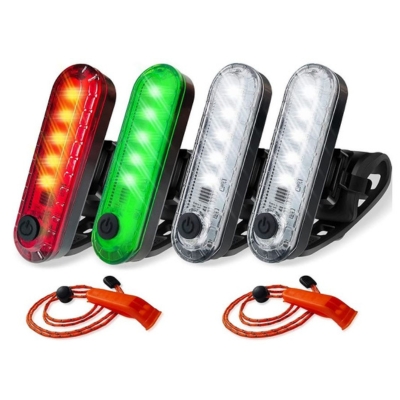
AMZONLY LED boat navigation lights are a versatile and top-rated kit with red and green LEDs for the bow and port side and white for the stern. They have three flashing modes and a magnetized screwdriver for easy battery changes.
This IPX5 weather-resistant light kit comes with four LEDs, 12 3-volt batteries, three elastic straps, one long armband, and a 12-month return policy. This is suitable for kayaks, yachts, motorboats, and pontoons and they can be used as a flush mount navigation light, masthead light, taillight, running light, or flashing light.
- Easy to install kit with everything you need
- One year return policy
- Solid waterproof and weatherproof capabilities
- Not intended to be submerged or soaked
Leaningtech LED Boat Navigation Lights

The LEANINGTECH Marine LED is a waterproof and adaptable lighting choice for boats that is known for its brightness, energy efficiency, and USCG compliance. Its durable construction from ABS plastic and chrome plaid zinc ensures both lightweight and waterproof properties with an IP65 rating.
It can serve various purposes that as a source of lighting for different types of boats. It can also serve as a bow, running, or stern light.
- Great brightness
- Easy to install and is made from quality materials
- Has multiple functions for use
- Gauge for wires is a bit small
- Some reports say it did not hold up well in salt water conditions
Osinmax Boat Navigation Light
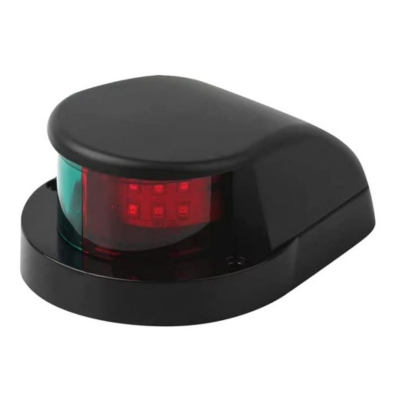
The Osinmax LED boat navigation lights is a top-rated energy-saving set that uses a 3W LED bulb and 12V DC power. With green and red lenses it offers masthead-like running lights that ensure you will be seen up to two miles.
The housing is waterproof with an IP67 high-density seal ring made of foam silicone rubber that helps prevent short circuits from splashes. The lights comply with maritime navigation, wildlife, and fisheries regulations, and install easily with one screw.
- Low power consumption and is super bright
- Designed to keep water out
- Can be used as courtesy lights
- Might need to add silicone to adhere the back side
- Might be difficult to install on some boats
Lumitec SeaBlazeX Boat Navigation Lights

To attain premium illumination you should opt for the Lumitec SeaBlazeX LED with 12-24V DC power that emits 4,000 lumens. Its marine-grade bronze housing enables convenient flat surface installation.
It offers versatile programmable features such as cross-fade and strobe. Perfect for subaquatic use, preventing discoloration, it is available in blue, green, white, and white/blue hues.
- Durable in salt water conditions
- Solid underwater submersion capabilities
- Bright lights in various colors
- Cannot dim lights
- Somewhat expensive compared to similar brands
Five Oceans Boat Navigation Lights

Boaters prefer Five Oceans' marine LED boat navigation lights for clear visibility up to two miles. These dual-function green and red lights serve as stern, flushing, and bow lights.
They are made of lightweight ABS plastic and alloy covers.They are also brighter and longer-lasting compared to other boat navigation lights.
These low-tension safety lights connect to a 12V power source for energy efficiency and superior visibility. With a UV-resistant feature and a lifespan of about 50,000 hours they are top choice. No additional sealing is required thanks to their rubber seal.
- IP66 protection and endure splashes
- Easily install the 3W bi-color LEDs at a 225-degree angle using the included screws
- Bright boat navigation lights that can be seen two miles away
- Does not look as appealing as other boat navigation lights
What to Expect from LED Boat Navigation Lights
To simplify your selection process when looking for LED lighting fixtures to accessorize, you will need to research a variety of factors based on your needs. If you wish to upgrade or replace your boat navigation lights here are some key factors to consider.
Lighting Capability
LED lights have evolved to meet diverse lighting needs with some producing clear white light and others providing brightness from any direction. Lumens is the term used to describe the amount of light generated by a particular brand of LED lights.
Angle of the Lights
To avoid eye damage it is crucial to factor in the beam angle when purchasing LED boat lights. Read reviews from past customers to gauge the intensity of the light directed at you or from an angle. Strong LED lighting fixtures can harm your eyes so be cautious.
Energy Efficiency
Comparing the percentage of energy needed to produce sufficient light is crucial when selecting lighting fixtures such as LED lights. Higher lumens per watt make LED lights more cost-effective in terms of energy consumption.
Red Light Output
Excessive heat generation in boat LED lights is a significant concern for buyers. To ensure optimal lighting quality it is crucial to consider the heat output of the chosen LED light.
Ease of Installation
Multiple installation techniques for navigation lights cater to different boating needs but mount components should be ensured for both wired and battery-operated choices. Mounting options range from screws to armbands.
Wired lights are recommended for safety while small boats can benefit from the versatility of battery-operated LED lights. The chosen installation method impacts functionality, service life, and safety, ultimately safeguarding lives and property.
LED light prices will vary depending on select features such as materials used and the manufacturer's design availability. Choosing a manufacturer depends on the buyer's budget and preferences for the intended use of the boating adventure.
Customized features and extended warranty may result in higher prices. To obtain the finest LED light bargain you should scrutinize LED boat lighting warranties that typically span from one to seven years. Do not settle for one that is the cheapest option since it might not suit your intended use or last as long as you may hope.
Quality Materials
To ensure the longevity of LED lights it is crucial for prospective buyers to consider the material used. If the material is prone to rust then the light will eventually corrode.
Always check the manufacturer's material-composition and avoid products made primarily of alloy coating. You should for opt for a top-grade metal or alloy material from a reputable LED light brand.
Your lighting source must be tightly sealed and capable of withstanding harsh weather and moisture. When using LED lights for marine and saltwater expeditions, verify the IP rating.
Look for an IP67 rated LED product. This means it confirms its ability to endure any weather conditions and even some underwater submersion.
Why You Need LED Boat Navigation Lights
LED navigation lights offer numerous benefits. They primarily are designed to allow safe transport on the waterways so that other boats can see you.
Choose quality LED lights for greater energy efficiency and significant cost savings compared to incandescent bulbs. LED lights have diverse uses on land and sea, being useful for lighting homes, businesses, and buildings.
Marine LED cabin lights have become popular as decorative lighting inside homes, while others use LEDs for entertainment, transportation, spotlighting, or reading. LEDs are considered essential lighting tools in any setting.
Other reasons to have efficient ones include:
- Easy installation and durable marine-grade construction
- Versatile performance options based on different brands
- Improved visibility for boat status and navigation
- Helps prevent accidents caused by extreme weather and reduced visibility
- Retain compliance with wildlife and marine laws
- Multiple usage options in other marine applications
Differences in LED Boat Navigation Lights
The boat light packaging is compact upon delivery and LED lights operate similarly to incandescent bulbs. They are initially designed for lighting boats but a lot of these lights now serve multiple purposes and come in various types.
- Navigation: Are essential for indicating the position and direction of sea vessels. Usually with red and green lights in addition to white.
- Anchor: The anchor light serves to locate and signal the presence of a docked vessel
- White: Provides adequate lighting all around the boat
- Deck: These lights offer lighting in areas that you walk through often
- Dock: Serve as bright illumination for boaters or mariners during departure or arrival at a marina
- Underwater: These are submerged or placed near water to lure sea creatures during nighttime fishing expeditions.
- Search: Search lights are essential for boat users to locate objects on deck or in water.
Which Colors Do You Need for Your Boat?
Boat navigation lights consist of red sidelight for port side and green sidelight for starboard side. White lights serve as anchor, masthead, or stern lights.
If you cannot remember how to tell the two apart you can always think of port red wine. There is a saying that you can easily remember such as “there is no red port wine left”. This way you do not have to worry about the starboard side since it works itself out in the phrase if you can remember the port side.
Navigation lights are unnecessary for illumination during normal boat motion except in low visibility conditions. If you decide to use other lights on your boat make sure that they are not in use during lower light conditions so that other boaters are not confused by your setup.
Related Articles
I've personally had thousands of questions about sailing and sailboats over the years. As I learn and experience sailing, and the community, I share the answers that work and make sense to me, here on Life of Sailing.
by this author
Most Recent
Important Legal Info
Lifeofsailing.com is a participant in the Amazon Services LLC Associates Program, an affiliate advertising program designed to provide a means for sites to earn advertising fees by advertising and linking to Amazon. This site also participates in other affiliate programs and is compensated for referring traffic and business to these companies.
Similar Posts
Popular posts.

Best Liveaboard Catamaran Sailboats
December 28, 2023

Can a Novice Sail Around the World?
Elizabeth O'Malley
June 15, 2022

4 Best Electric Outboard Motors

How Long Did It Take The Vikings To Sail To England?

10 Best Sailboat Brands (And Why)
December 20, 2023

7 Best Places To Liveaboard A Sailboat
Get the best sailing content.
Top Rated Posts
Lifeofsailing.com is a participant in the Amazon Services LLC Associates Program, an affiliate advertising program designed to provide a means for sites to earn advertising fees by advertising and linking to Amazon. This site also participates in other affiliate programs and is compensated for referring traffic and business to these companies. (866) 342-SAIL
© 2024 Life of Sailing Email: [email protected] Address: 11816 Inwood Rd #3024 Dallas, TX 75244 Disclaimer Privacy Policy
Navigation lights for boats at night
- Free Boating License Study Guide
- Boating Safety Equipment required
- Navigation lights
Specific lighting configurations are required for boats operating between sunset and sunrise or in times of restricted visibility. It's your responsibility to make sure your boat shows the proper lights depending on its size and the waters on which you are operating.
The U.S. Coast Guard Navigation Rules , International-Inland encompasses lighting requirements for every description of watercraft. The information provided here is intended for power-driven boats and sailboats less than 20 meters (65.62 feet) long. The various options are illustrated.
Navigation lights should be checked prior to departing the dock, and you should always carry spare bulbs. The USCG doesn’t care if they were working when you left, only that they are working when required.

Power-driven vessels of less than 20 meters (65.62 feet) navigation lights at night

Power-driven vessels of less than 7 meters (23 feet) navigation lights

whose maximum speed cannot exceed 7 knots may exhibit an all-around white light (360 degrees) and, if practicable, sidelights instead of the lights prescribed above, in international waters only .
Sailing Vessels of less than 20 meters (65.62 feet) navigation lights at night
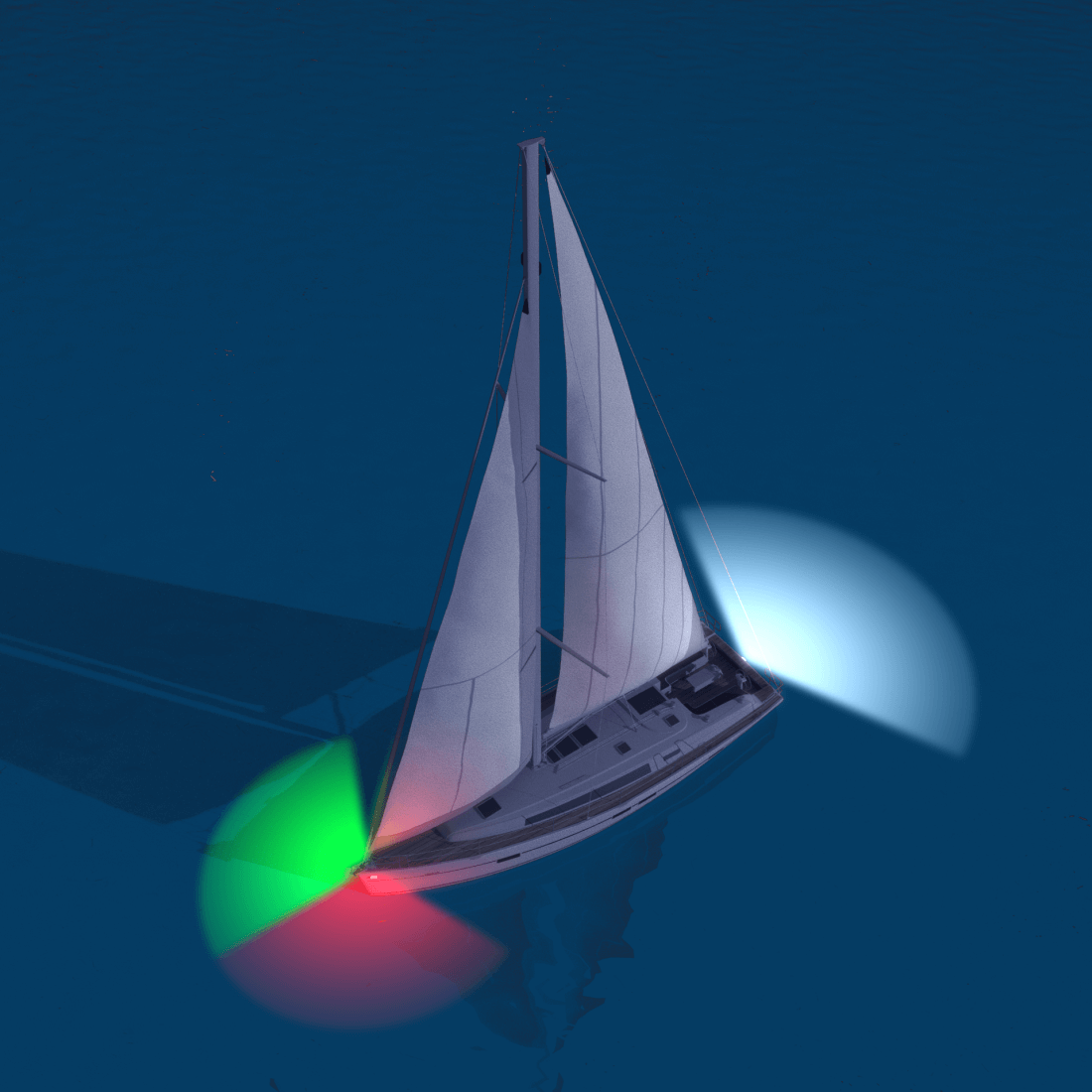
Sailing vessels less than 7 meters may carry an electric torch or lighted lantern showing a white light to be displayed in sufficient time to prevent collision. If practicable, the lights prescribed for sailing vessels less than 20 meters should be displayed.
Kayaks & canoes navigation lights

A canoe or kayak may display the lights prescribed for sailing vessels, but if not, must have ready at hand an electric torch or lighted lantern (flashlight) showing a white light to be displayed in sufficient time to prevent collision.
Anchored vessels navigation lights
Power-driven vessels and sailing vessels at anchor must display anchor lights. An anchor light for a vessel less than 50 meters in length is an all-around white light visible for 2 miles and exhibited where it can best be seen.
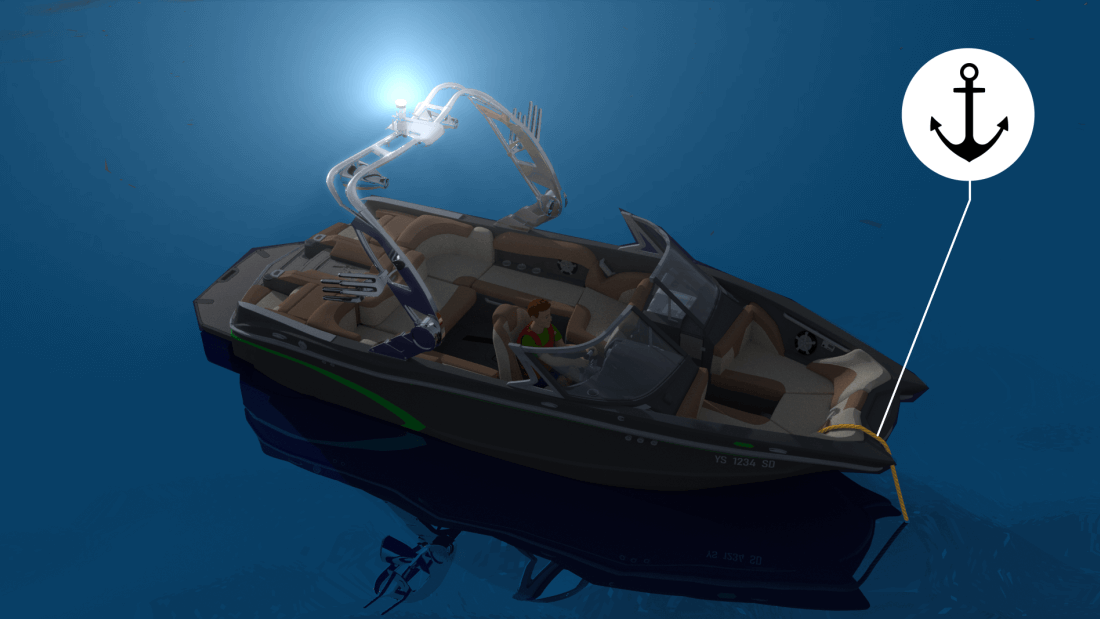
Vessels less than 7 meters are not required to display anchor lights or day shapes unless anchored in or near a narrow channel, fairway or anchorage , or where other vessels normally navigate. Anchor lights are not required on vessels less than 20 meters, anchored in special anchorages in inland waters designated by the Secretary of Transportation.
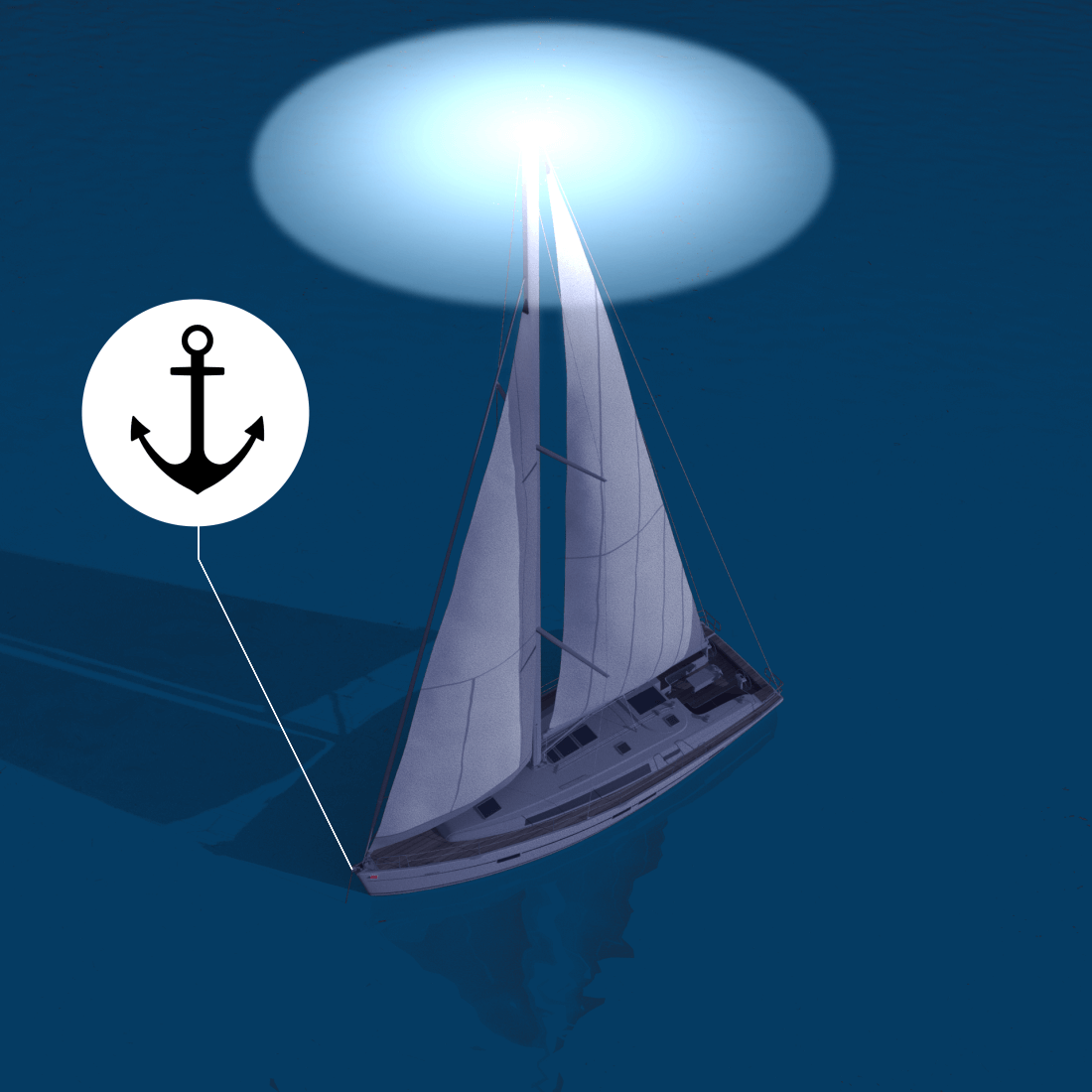
Law enforcement vessel
A flashing blue light indicates a law enforcement vessel. Do not impede its operation
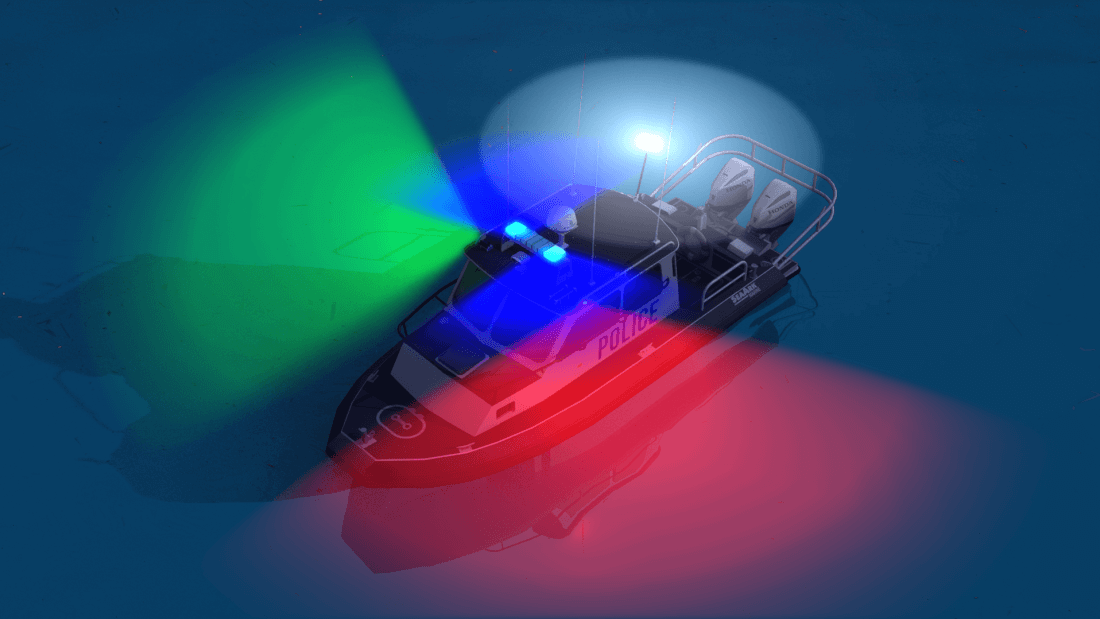
Towing vessel navigation lights
If you see yellow lights or a flashing yellow light, stay away, it is a towing vessel with an object in tow.
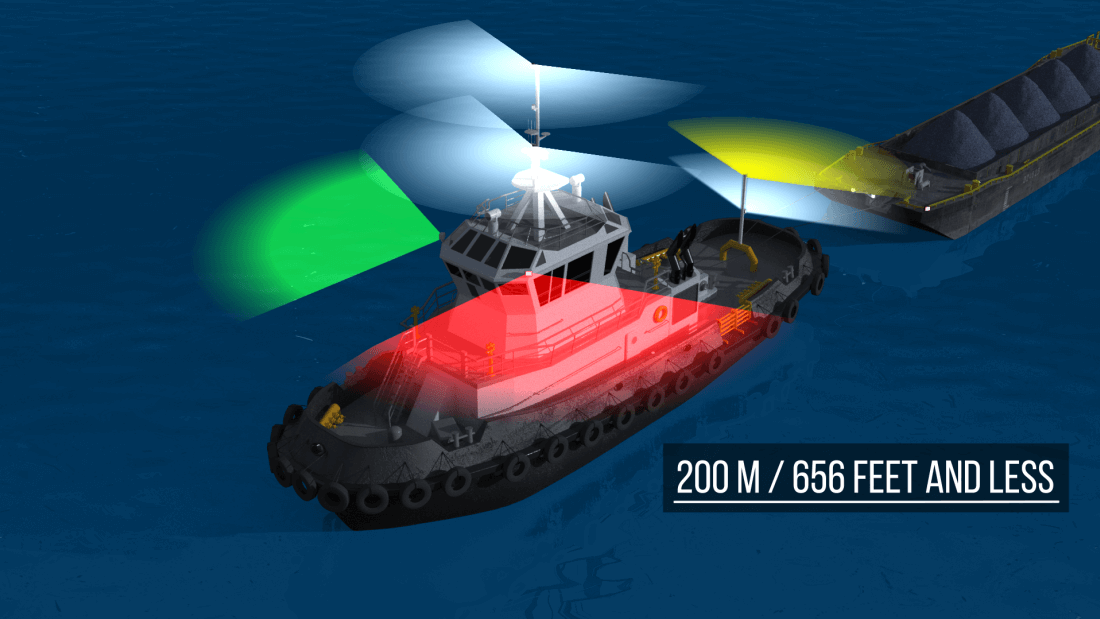
- Follow Ace Boater on YouTube
- Join Ace Boater on Facebook
- Contacts Us
Boating safety course and boating exam accredited in USA

RVZONE Boat Navigation Lights, Boat Red and Green Bow Lights... › Customer reviews
Customer reviews.

RVZONE Boat Navigation Lights, Boat Red and Green Bow Lights Navigation Lights for Boats Led Deck Lights for Night Fishing, Yacht, Kayak, Bass Boat, Pontoon Boat
Customer Reviews, including Product Star Ratings help customers to learn more about the product and decide whether it is the right product for them.
To calculate the overall star rating and percentage breakdown by star, we don’t use a simple average. Instead, our system considers things like how recent a review is and if the reviewer bought the item on Amazon. It also analyzed reviews to verify trustworthiness.
Top positive review
Top critical review
There was a problem filtering reviews right now. Please try again later.
From the united states, there was a problem loading comments right now. please try again later..
- ← Previous page
- Next page →
Questions? Get fast answers from reviewers
- Amazon Newsletter
- About Amazon
- Accessibility
- Sustainability
- Press Center
- Investor Relations
- Amazon Devices
- Amazon Science
- Start Selling with Amazon
- Sell apps on Amazon
- Supply to Amazon
- Protect & Build Your Brand
- Become an Affiliate
- Become a Delivery Driver
- Start a Package Delivery Business
- Advertise Your Products
- Self-Publish with Us
- Host an Amazon Hub
- › See More Ways to Make Money
- Amazon Visa
- Amazon Store Card
- Amazon Secured Card
- Amazon Business Card
- Shop with Points
- Credit Card Marketplace
- Reload Your Balance
- Amazon Currency Converter
- Your Account
- Your Orders
- Shipping Rates & Policies
- Amazon Prime
- Returns & Replacements
- Manage Your Content and Devices
- Recalls and Product Safety Alerts
- Conditions of Use
- Privacy Notice
- Your Ads Privacy Choices

COMMENTS
As such a power boat, and by extension all sailboats, MUST, without question show one green light on the starboard bow and one red light on the port bow and one all around white light or lights while operating in reduced visibility. These lights should shine at all 360 degrees of visibility with the bow lights shining at an angle of dead ahead ...
For most small vessels, motoring requires red and green (port and starboard) lights, and a white light visible in all directions around the boat. This is almost always a stern light and a masthead light on sailboats. Boats under sail require port and starboard lights, and a white stern light. Sailboats below sixty-five feet may show a tricolor ...
Portable Lights for Inflatable Boats, Kayaks and Canoes. Watching the sunset over the water from your kayak is a great way to relax, until you realize you have to paddle back in the dark while being practically invisible to other boats. West Marine portable navigation light kits assure visbility while you enjoy the water after dark like ...
Boat Navigation Light Regulations. Several rules and specifications are related to the type, size, layout, arc, and distance of visibility of boat navigation lights used by all vessel types which are collectively known as the International Regulations for Preventing Collisions at Sea or COLREGs.The navigational lights used are known as 'COLREG lights and shapes.
On any vessel, navigation lights have a specific color, (white, red, green, yellow, blue), arc of illumination, range of visibility, and location, as required by law and regulations. For the purposes of this course, we will concentrate on pleasure boats under 65 feet in length. Knowledge of navigation lights is important to a small-boat skipper ...
The basic rule is that sidelights and a stern light are required. Permissible variations to this rule appear below. Sailboats less than 20m (65.7') can substitute a tricolor light for separate sidelights and stern light—or a bi-color light and a stern light may be substituted. Sailboats less than 7m (23') shall, if practicable, exhibit lights ...
Attwood 14190 Boat Navigation Lights. Kitting out your boat with all the needed lights doesn't have to involve buying several products. These lights come with red and green navigation lights, a white LED stern light, hardware, a pole, and a C-clamp for simple mounting. In addition, each light is battery-powered with a shatterproof ...
Sailboats - A combination of red and green sidelights should be used along with a white aft light on sailing vessels. Navigation Lights Maintenance and Inspection. It's essential to stay on top of maintenance and inspection for your boat navigation lights. Follow this guideline:
Power boats less than 20 meters shall exhibit navigation lights as shown in Figure 1. (Note: 2 masthead lights are optional for vessels under 50 meters. Vessels over 50 meters will display two masthead lights.) Figure 2. Vessels of less than 12 meters in length, may show the lights in either Figure 1 or Figure 2.
As a seasoned boater or a seafaring enthusiast, your understanding of marine navigation lights can make a vast difference in your nocturnal and low-visibility voyages.Precision in navigating the open waters lies not only in skill but also in the silent language of luminescence, communicated through the boat navigation lights.Whether adrift at twilight or in the embrace of a foggy morning ...
Vessel length: 12 meters to 20 meters (39.4 FT. to 65.6 FT.) Lighting requirement: A white masthead light located at the front of the boat, pointing in the direction you are traveling. This must be visible at 225 degrees and from two miles away. The masthead light must be positioned at least 8 feet above the gunnel.
Powerboat under 23 feet (7m) Powerboats under 23 feet are required to have the following navigation lights displayed: One white masthead light visible for 2 miles. One red & green sidelight visible for 1 mile. One stern light visible for 2 miles. One white, red, green, or yellow all-round light visible for 2 miles.
In the past, the most popular means of meeting the U.S. Coast Guard's navigation light requirements for boats under 65 feet (see "Nav Light Requirements," below) was to use an Aqua Signal Series 40 tri-color lamp housing with its long-filament incandescent bulb. Its 25-watt energy appetite not only puts a significant load on the house ...
23 - Power driven vessels over 12m must have a forward-facing steaming light plus sidelights and a stern light below the level of the steaming light. 25 - Sailing vessels Underway shall exhibit sidelights (red/green) as either a combined or as separate lights, and a white stern light. 30 - Anchored Vessels under 50m shall exhibit an all-round ...
Boats under 23' may carry a 360° lantern or flashlight in lieu of running lights. Also, international regulations allow sailboats under 65.6' (20 meters) to display a single masthead tricolor navigation light while under sail. All-around lights must be a minimum of 1 meter (39 3/8") above the red/green sidelights on boats under 12 meters (39.4 ...
Navigation lights are an important element of boating safety equipment for all boats, including sailboats and human-powered vessels. If you are operating a sailboat or nonpowered boat such as a canoe, kayak or rowboat, you need to know when to use navigation lights.You also need to be aware of the correct configuration of navigation lights for your boat size and boating circumstances.
A masthead light (a white light at the front of the boat). The masthead light needs to be visible across 225 degrees and from at least two miles away. A pair of red and green side lights, each visible across 112.5 degrees and from a mile away. A stern light (a white light at the rear of the boat). The stern light needs to visible across 135 ...
2 NM Stern Brass Nav Light - Boats to 12m, 12V DC. SKU: 1002090 | Item ID: DVY 0113/BR. 1-45 results of 334. Professionals and enthusiasts get their boat navigation lights from Fisheries Supply. Shop for LED lighting from top brands like Aqua Signal, Perko, Hella, and more.
The upper light should be red and the lower light should be green. This option is rarely used today, but is still accepted. Again, the red and green all-round lights at the top of the mast can only be used while under sail. Visibility of navigation lights for sailboats this size should be as follows: Masthead light - 3 NM
Together, the side and stern lights make a complete circle of light around the boat. Smaller, slower boats may be able to substitute a white all-around light for separate side and stern lights. The all-around light must make a 360° circle of light around the boat. Side, stern and all-round are the main navigation lights boats need.
A bi-colored boating navigation light is for the bow and the all-around navigation light will be on the back or center of the boat body. The bi-colored light will be at a 225 degree spread and the all-around light will be a 360 degree spread light. If the boat is about 13 meters (39.79), the boat must have red and green lights on the side of ...
AMZONLY LED boat navigation lights are a versatile and top-rated kit with red and green LEDs for the bow and port side and white for the stern. They have three flashing modes and a magnetized screwdriver for easy battery changes. This IPX5 weather-resistant light kit comes with four LEDs, 12 3-volt batteries, three elastic straps, one long ...
Anchored vessels navigation lights. Power-driven vessels and sailing vessels at anchor must display anchor lights. An anchor light for a vessel less than 50 meters in length is an all-around white light visible for 2 miles and exhibited where it can best be seen. Vessels less than 7 meters are not required to display anchor lights or day shapes ...
Find helpful customer reviews and review ratings for RVZONE Boat Navigation Lights, Boat Red and Green Bow Lights Navigation Lights for Boats Led Deck Lights for Night Fishing, Yacht, Kayak, Bass Boat, Pontoon Boat at Amazon.com. Read honest and unbiased product reviews from our users.